Cisco 300-410 Implementing Cisco Enterprise Advanced Routing and Services (300-410 ENARSI) Exam Practice Test
Implementing Cisco Enterprise Advanced Routing and Services (300-410 ENARSI) Questions and Answers
:590
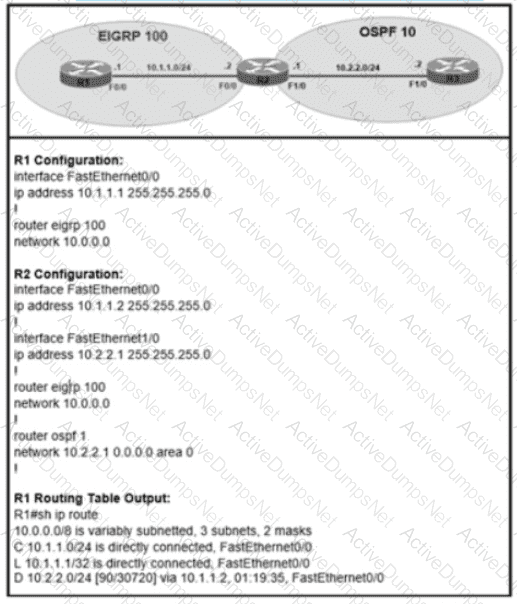
Refer to the exhibit The R2 OSPF route 10 2 2 0/24 shows in the R1 EIGRP routing table without route redistribution performed between OSPF and EIGRP routing protocols Which configuration is required on router R2 to resolve the issue?
What is the purpose of the DHCPv6 Guard?
A CoPP policy is applied for receiving SSH traffic from the WAN interface on a Cisco ISR4321 router.
However, the SSH response from the router is abnormal and stuck during the high link utilization. The problem is identified as SSH traffic does not match in the ACL. Which action resolves the issue?
Refer to the exhibit.
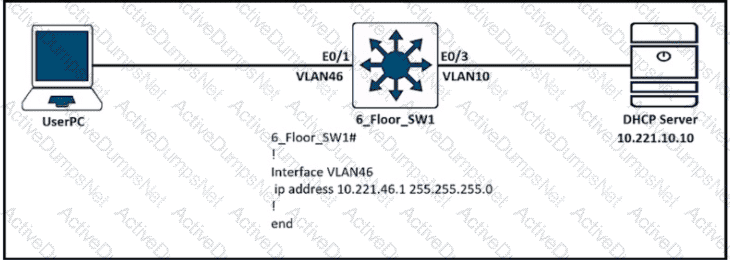
Users in VLAN46 cannot get the IP from the DHCP server. Assume that all the parameters are configured properly in VLAN 10 and on the DHCP server Which command on interlace VLAN46 allows users to receive IP from the DHCP server?
Refer to the exhibit.
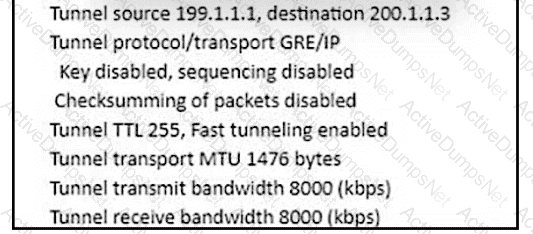
An engineer must establish a point-to-point GRE VPN between R1 and the remote site. Which configuration accomplishes the task for the remote site?
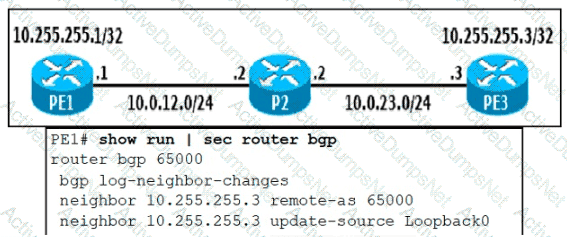
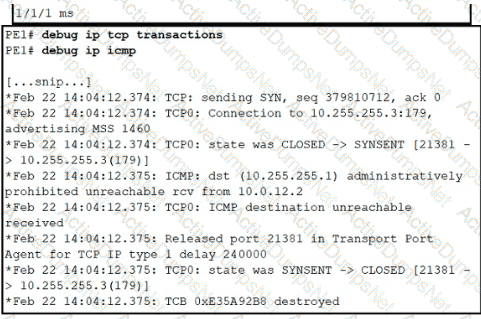
Refer to the exhibit. The administrator is troubleshooting a BGP peering between PE1 and PE3 that is unable to establish Which action resolves the issue?

Refer lo lhe exhibit. The Customer Edge rouler wants to use AS 100 as the preferred ISP for all external routes and ISP-2 as a backup.
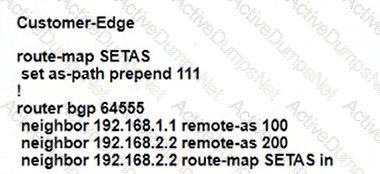
After this configuration, all the backup routes have disappeared from the BGP table on the Customer Edge router. Which set of configurations resolves the issue on the Customer Edge router?
A)
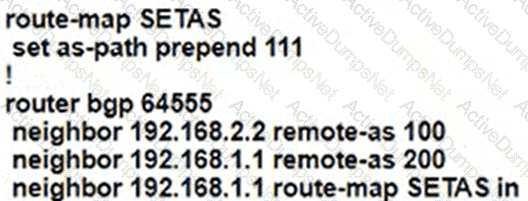
B)
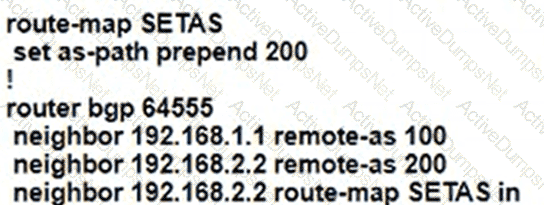
C)
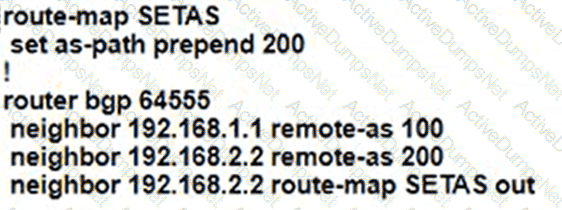
D)
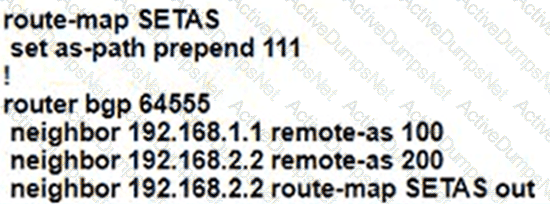
A network administrator added a new spoke site with dynamic IP on the DMVPN network. Which configuration command passes traffic on the DMVPN tunnel from the spoke router?
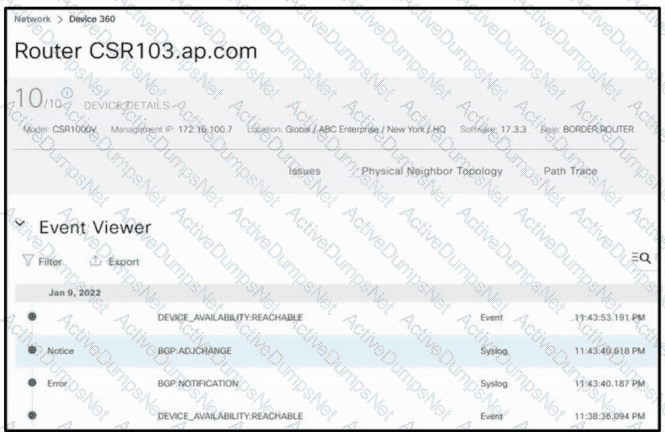

Refer to the exhibit. The BGP connection went from Established to Active when a new router was provisioned between CSR301 and its eBGP peers. Which command resolves the IPv4 peering problem?
Refer to the exhibit.
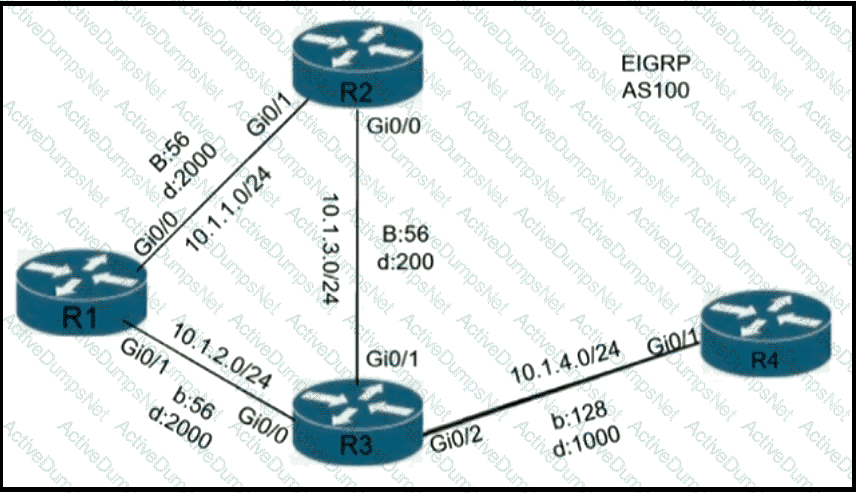
A loop occurs between R1, R2, and R3 while EIGRP is run with poison reverse enabled. Which action prevents the loop between R1, R2, and R3?
Refer to the exhibit.
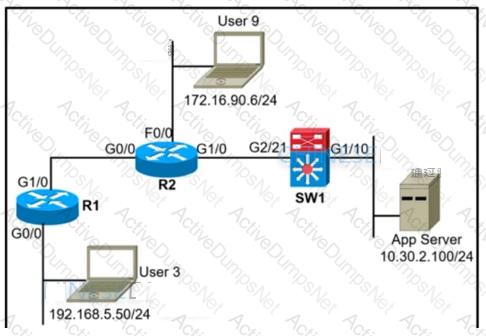
A network administrator must block ping from user 3 to the App Server only. An inbound standard access list is applied to R1 interface G0/0 to block ping. The network administrator was notified that user 3 cannot even ping user 9 anymore. Where must the access list be applied in the outgoing direction to resolve the issue?
Refer to the exhibit.

Spoke routers do not learn about each other's routes in the DMVPN Phase2 network. Which action resolves the issue?
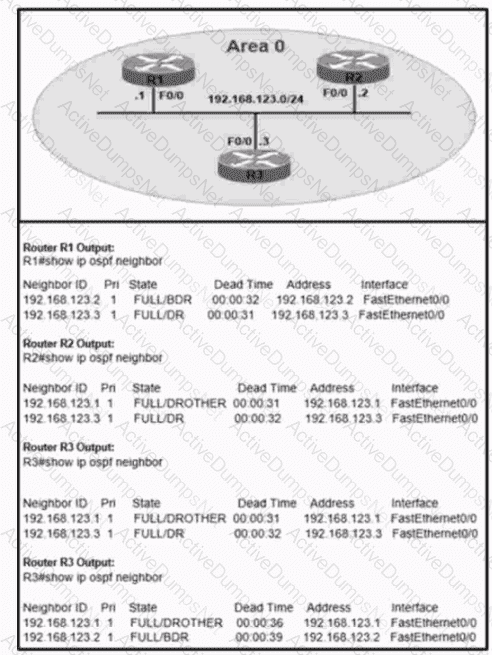
Refer to the exhibit. An administrator wanted to make R1 always elected as DR. R2 as BDR. and R3 as DROTHER but could not achieve the desired results. Which two configurations resolve the issue? (Choose two.)
What must be configured by the network engineer to circumvent AS_PATH prevention mechanism in IP/VPN Hub and Spoke deployment scenarios?
Refer to the exhibit.
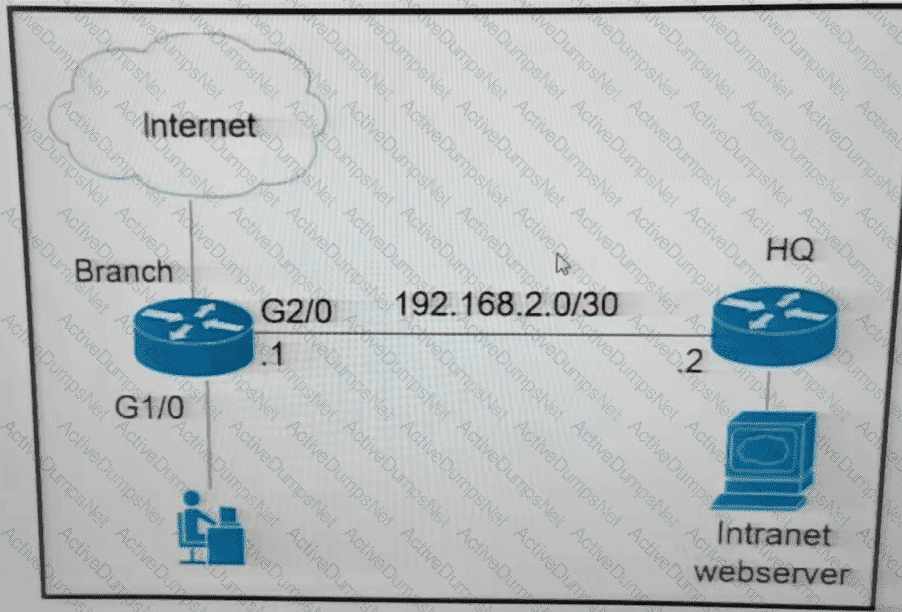
The branch router is configured with a default route toward the internet and has no routes configured for the HQ site that is connected through interface G2/0. The HQ router is fully configured and does not require changes. Which configuration on the branch router makes the intranet website (TCP port 80) available to the branch office users?
A)

B)
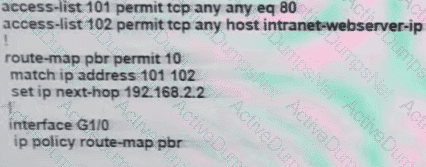
C)
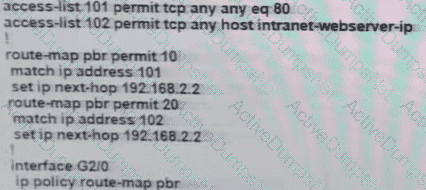
D)

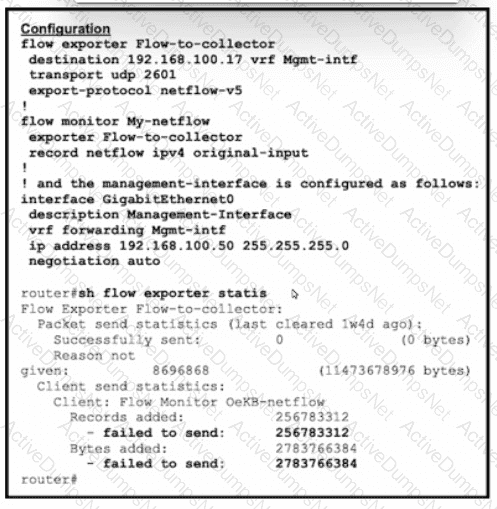
Refer to the exhibit. A network administrator configured NetFlow data, but the data is not visible at the NetFlow collector. Which configuration allows the router to send the records?
Refer to the exhibit.
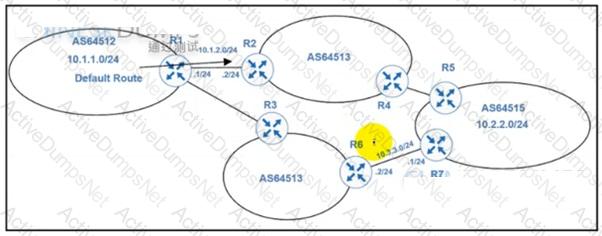
An engineer must configure PBR on R1 to reach to 10.2.2.0/24 via R3 AS64513 as the primary path and a backup route through default route via R2 AS64513. All BGP routes are in the routing table of R1. but a static default route overrides BGP routes. Which PBR configuration achieves the objective?
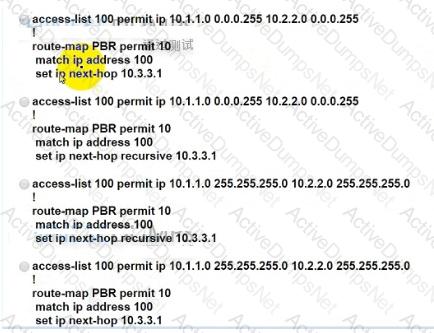
Refer to the exhibit.
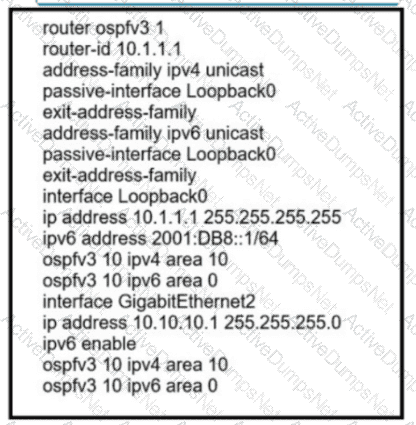
An administrator must configure the router with OSPF for IPv4 and IPv6 networks under a single process. The OSPF adjacencies are not established and did not meet the requirement. Which action resolves the issue?
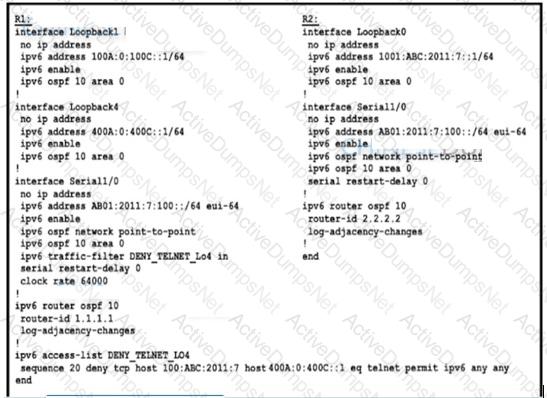
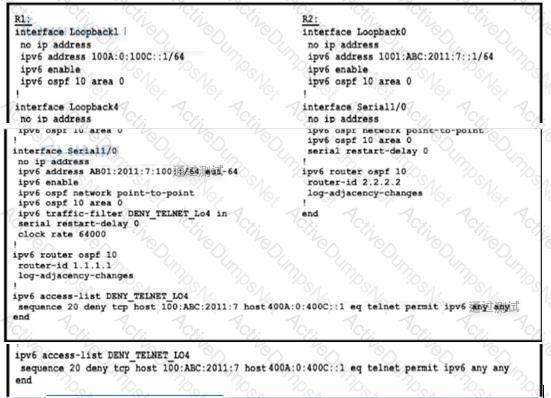
Refer to the exhibit. An engineer implemented an access list on R1 to allow anyone to Telnet except R2 Loopback0 to R1 Loopback4 How must sequence 20 be replaced on the R1 access list to resolve the issue?
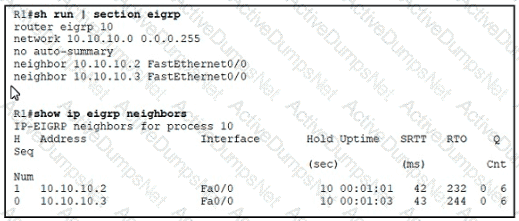
Refer to the exhibit The remote branch locations have a static neighbor relationship configured to R1 only R1 has successful neighbor relationships with the remote locations of R2 and R3, but the end users cannot communicate with each other. Which configuration resolves the issue’
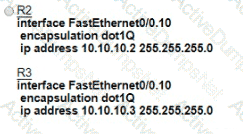
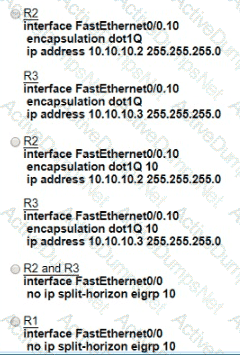
An engineer is creating a policy that overrides normal routing behavior.if the route to a destination of
10.100.100.0/24 is withdrawn from the routing
Table, the policy must direct traffic to a next hop of 10.1 1.1. if the route is present in the routing table, then
normal forwarding must occur. Which
configuration meets the requirements?
Refer to the exhibit.
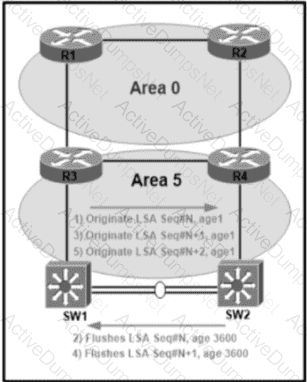
An error message "an OSPF-4-FLOOD_WAR” is received on SW2 from SW1. SW2 is repeatedly receiving its own link-state advertisement and flushes it from the network. Which action resolves the issue?
A network is configured with IP connectivity, and the routing protocol between devices started having problems right after the maintenance window to implement network changes. Troubleshoot and resolve to a fully functional network to ensure that:
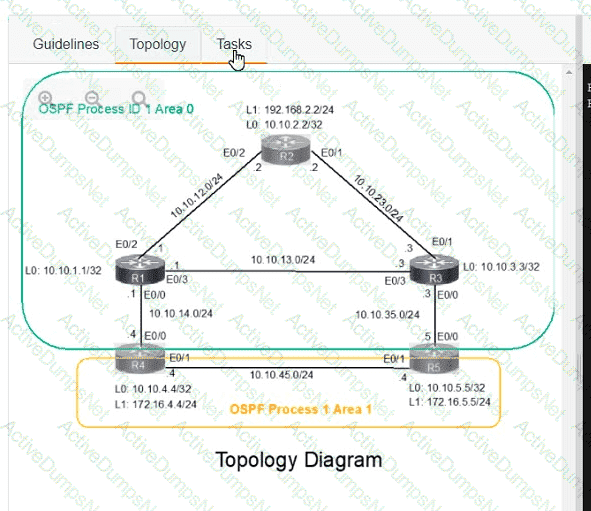
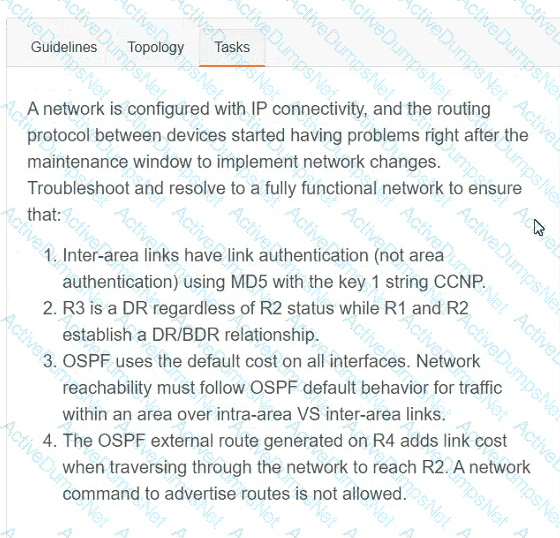
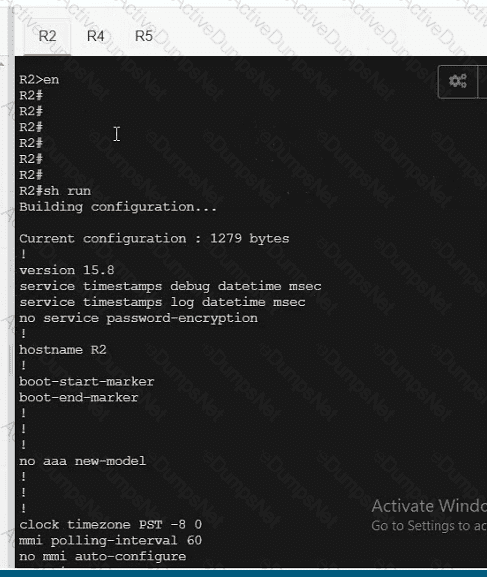

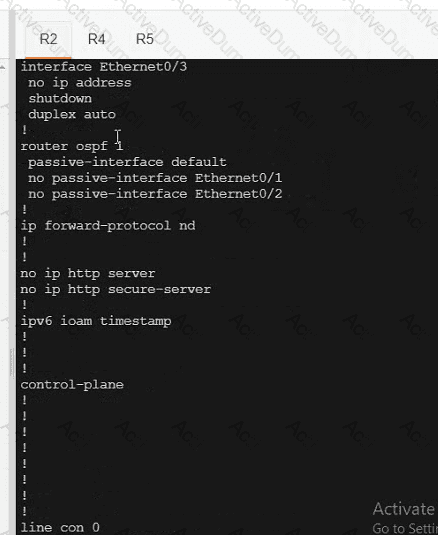
R4
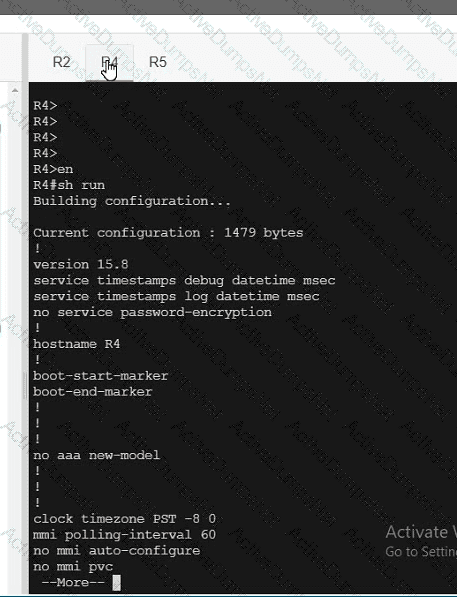
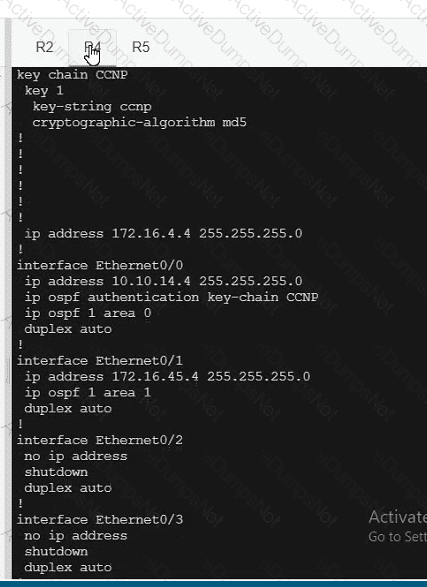
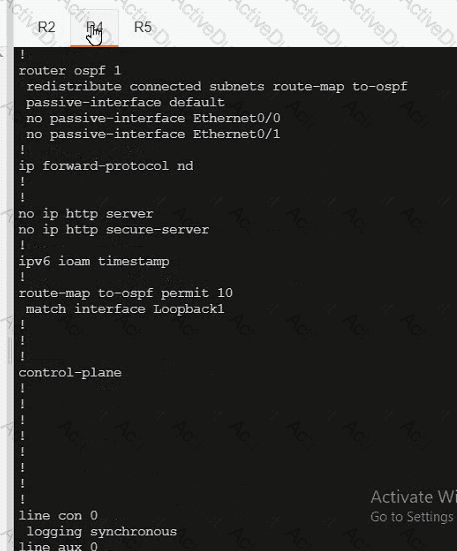
R5
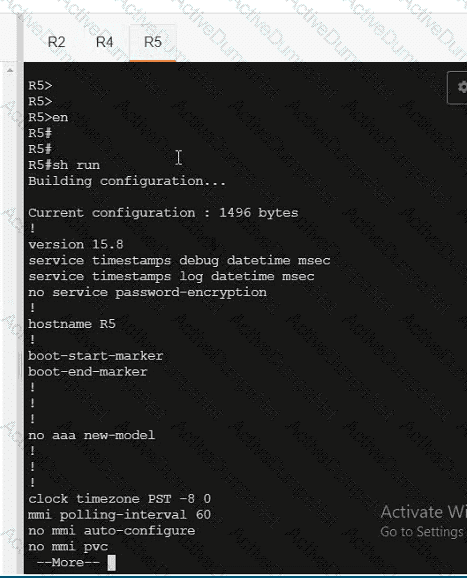
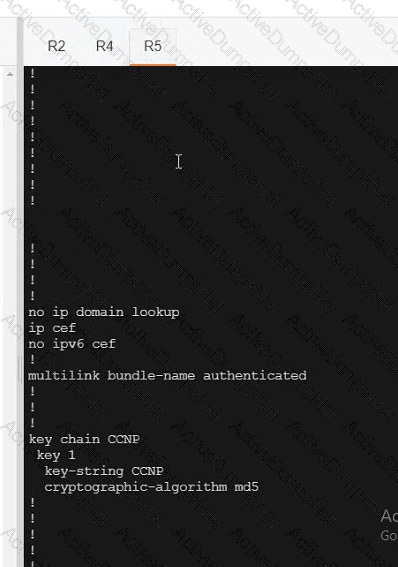
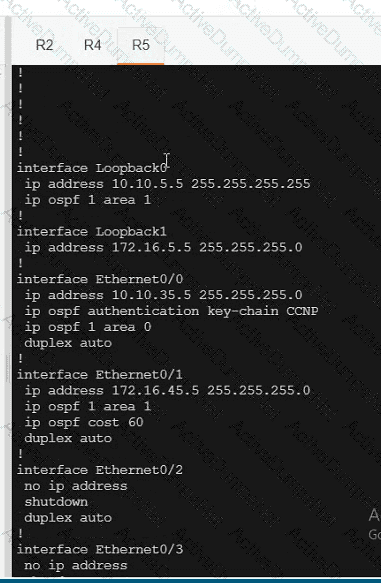
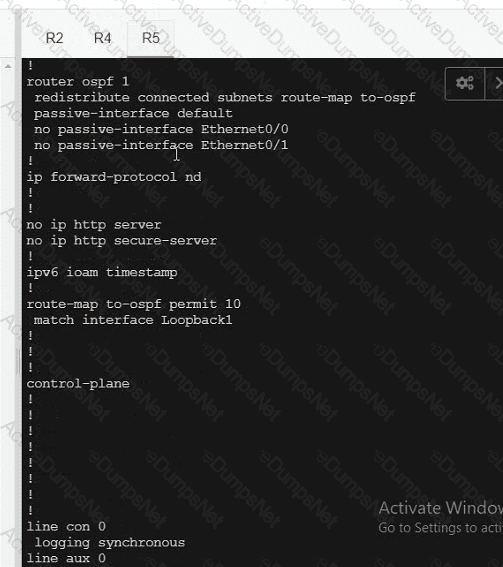
The network administrator configured CoPP so that all SNMP traffic from Cisco Prime located at 192.168.1.11 toward the router CPU is limited to 1000 kbps. Any traffic that exceeds this limit must be dropped.
access-list 100 permit udp any any eq 161
!
class-map CM-SNMP
match access-group 100
!
policy-map PM-COPP
class CM-SNMP
police 1000 conform-action transmit
!
control-plane
service-policy input PM-COPP
The network administrator is not getting the desired result for the SNMP traffic and SNMP traffic is getting dropped frequently. Which set of configurations resolves the issue?
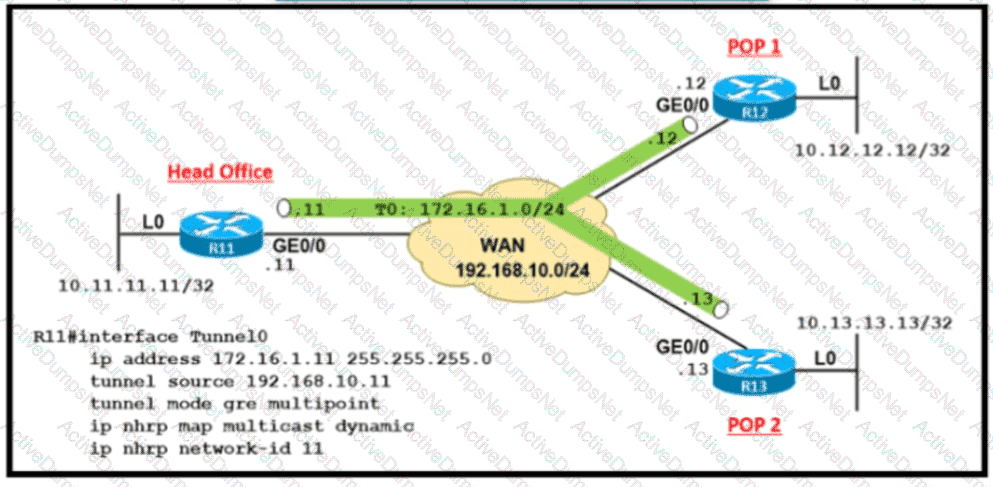
Refer to the exhibit A company builds WAN infrastructure between the head office and POPs using DMVPN hub-and-spoke topology to provide end-to-end communication All POPs must maintain point-to-point connectivity with the head office Which configuration meets the requirement at routers R12 and R13?
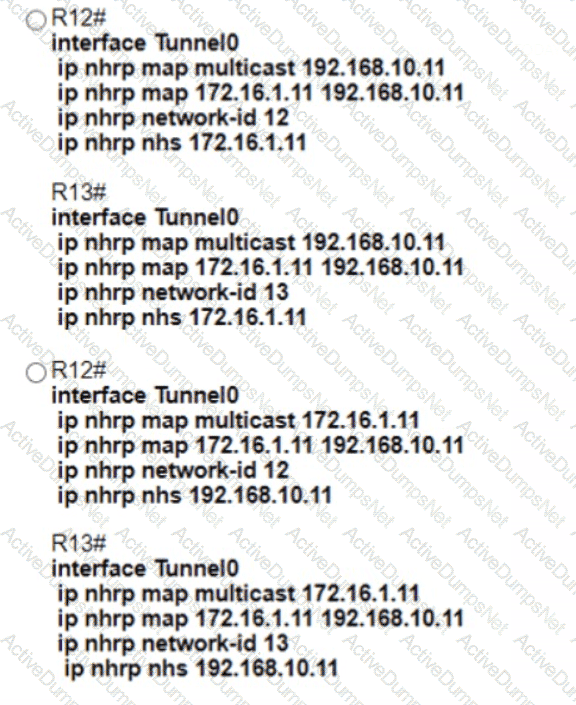
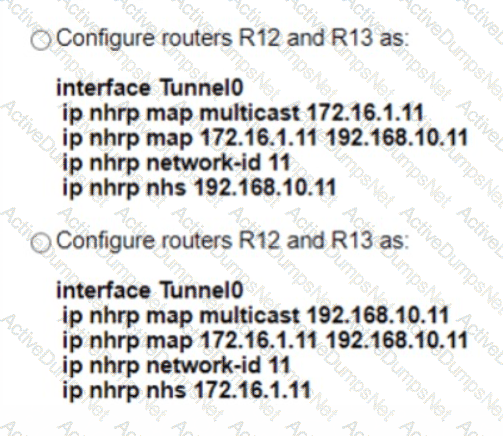
How are LDP neighbors discovered?
Refer to the exhibit.

The network administrator configured the Chicago router to mutually redistribute the LA and NewYork routes with OSPF routes to be summarized as a single route in EIGRP using the longest summary mask:
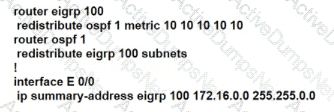
After the configuration, the New York router receives all the specific LA routes but the summary route. Which set of configurations resolves the issue on the Chicago router?
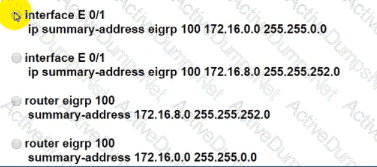
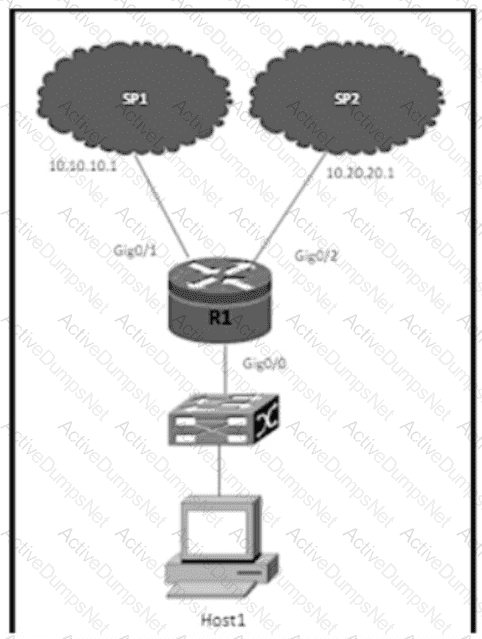
Refer to the exhibit. R1 uses SP1 as the primary path. A network engineer must force all SSH traffic generated from R1 toward SP2. Which configuration accomplishes the task?
A)

B)
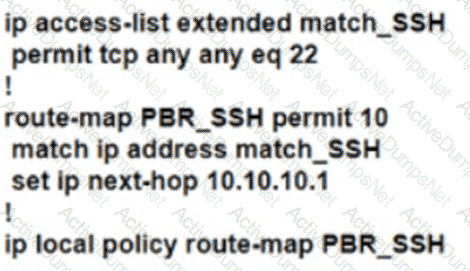
C)
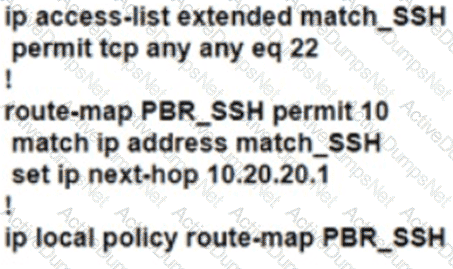
D)
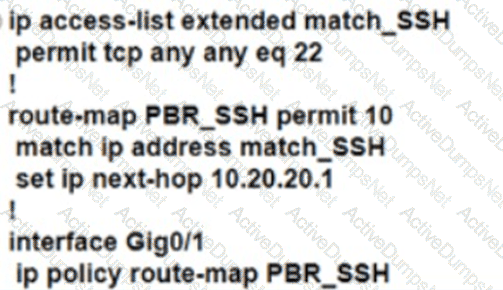

Refer to the exhibit. A network engineer is troubleshooting a failed link between R2 and R3 No traffic loss is reported from router R5 to HQ Which command fixes the separated backbone?
What are two features of BFD? (Choose two.)
An engineer creates a default static route on a router with a hop of 10.1.1.1. On inspection, the engineer finds the router has two VRFs, Red and Blue. The next hop is valid for both VRFs and exists in each assigned VRF. Which configuration achieves connectivity?
A)

B)

C)

D)

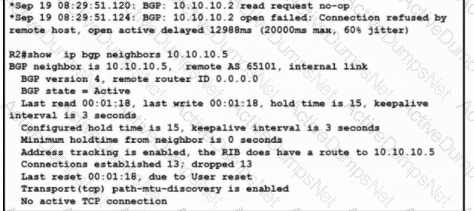

Refer to the exhibit. A customer reports a failure and intermittent disconnection between two office buildings, site X and site Y. The network team determines that both sites are exchanging email application traffic with the data center network. Which configuration resolves the issue between site X and site Y?
Refer to the exhibit.
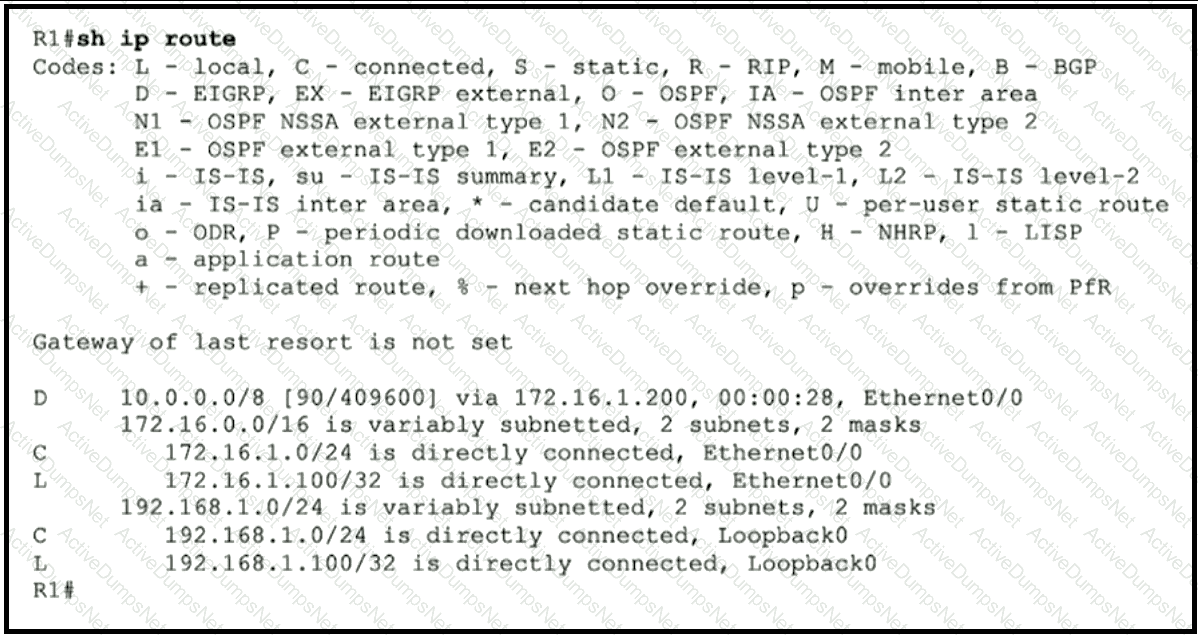
The R2 loopback interface is advertised with RIP and EIGRP using default values. Which configuration changes make R1 reach the R2 loopback using RIP?
Refer to the exhibit.
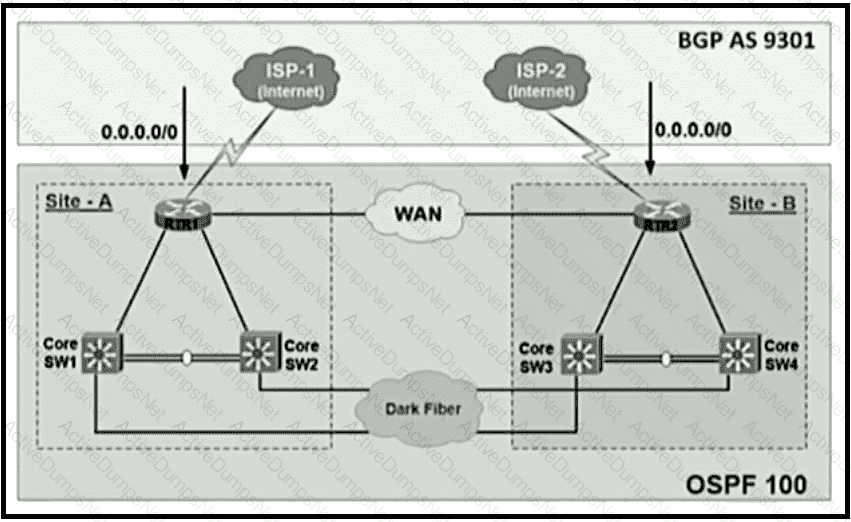
The Internet traffic should always prefer Site-A ISP-1 if the link and BGP connection are up; otherwise, all Internet traffic should go to ISP-2 Redistribution is configured between BGP and OSPF routing protocols and it is not working as expected. What action resolves the issue?
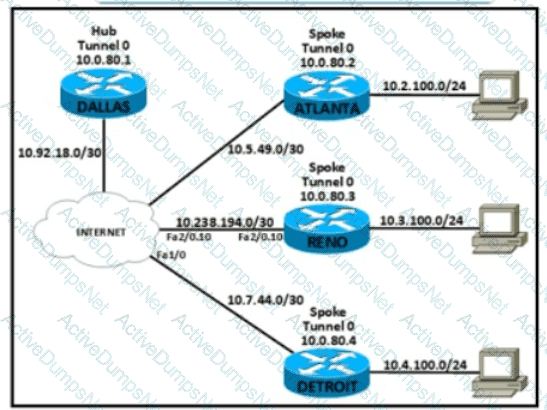
Refer to the exhibit An engineer must connect the Reno and Detroit spokes using DMVPN phase 2 Hub tunnel configuration is
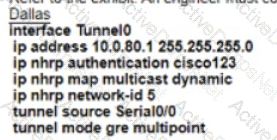
Which configuration accomplishes the task?
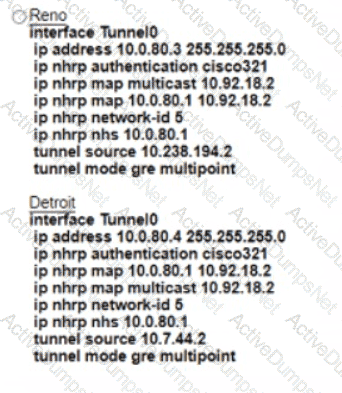

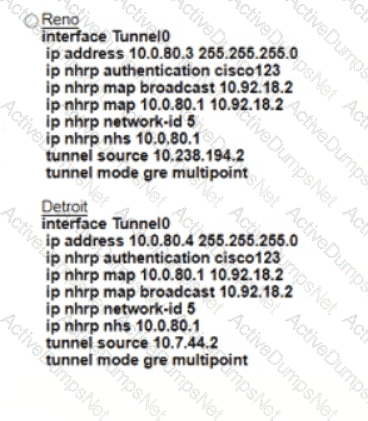
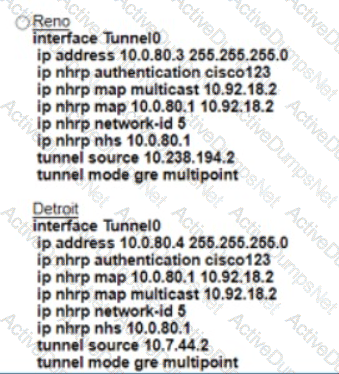
Which protocol must be secured with MD-5 authentication across the MPLS cloud to prevent hackers from introducing bogus routers?
The network administrator configured CoPP so that all routing protocol traffic toward the router CPU is
limited to 1 mbps. All traffic that exceeds
this limit must be dropped. The router is running BGP and OSPF Management traffic for Telnet and SSH
must be limited to 500kbps.
access-list 100 permit tcp any any eq 179
access-list 100 permit tcp any any range 22 23
access-list 100 permit ospf any any
!
class-map CM-ROUTING
match access-group 100
class-map CM-MGMT
match access-group 100
!
policy-map PM-COPP
class CM-ROUTING
police 1000000 conform-action transmit
class CM-MGMT
police 500000 conform-action transmit
!
control-plane
service-policy output PM-COPP
No traffic is filtering through CoPP,which is resulting in high CPU utilization,which configuration resolves
the issue ?
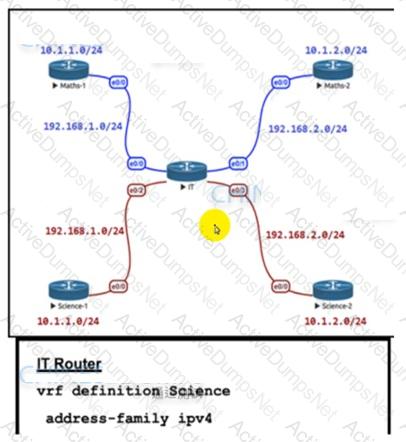

Refer to the exhibit. The IT router has been configured with the Science VRF and the interfaces have been assigned to the VRF. Which set of configurations advertises Science-1 and Science-2 routes using EIGRPAS 111?
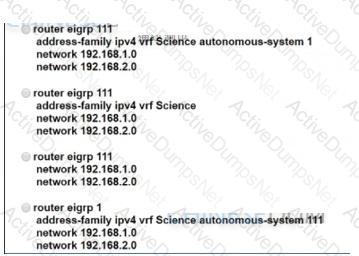

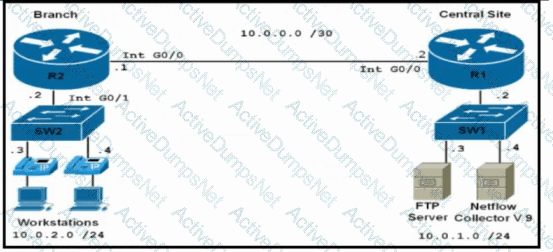
Refer to the exhibit. An engineer uses NetFlow to troubleshoot a voice quality issue from the branch office and notices that the traffic is not arriving in the correct format to the collector. Which configuration resolves the issue?
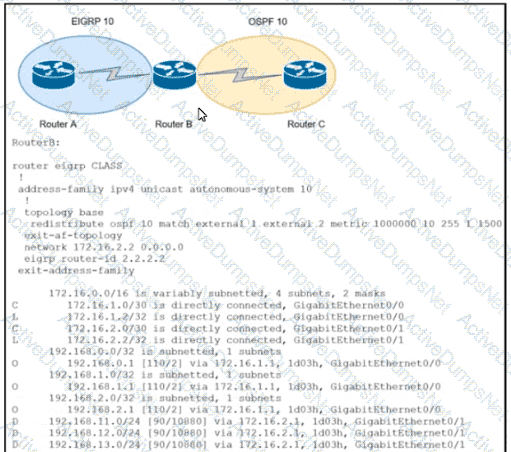
Refer to the exhibit. An engineer configured route exchange between two different companies for a migration project EIGRP routes were learned in router C but no OSPF routes were learned in router A. Which configuration allows router A to receive OSPF routes?
Refer to the exhibit.

A prefix list is created to filter routes inbound to an EIGRP process except for network 10 prefixes After the prefix list is applied no network 10 prefixes are visible in the routing table from EIGRP. Which configuration resolves the issue?
Refer to the exhibit.
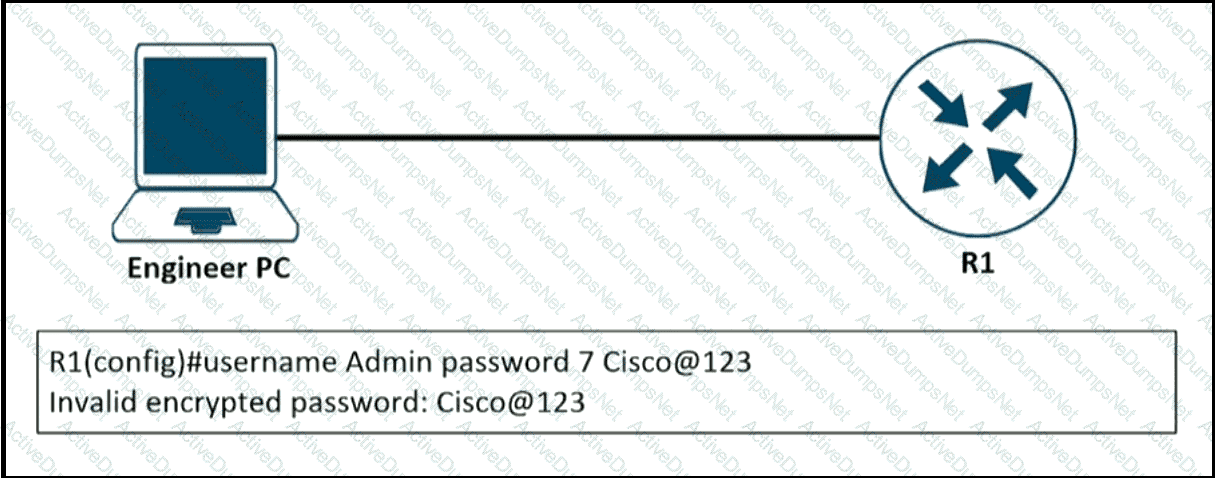
An engineer is trying to add an encrypted user password that should not be visible in the router configuration. Which two configuration commands resolve the issue? (Choose two)
How are CE advertised routes segmented from other CE routers on an MPLS PE router?
Which MPLS value is combined with the IP prefix to convert to a VPNv4 prefix?
Refer to the exhibit.

R4 is experiencing packet drop when trying to reach 172.16.2.7 behind R2. Which action resolves the issue?

Refer to the exhibit. A network engineer configured routers R1 and R2 with MP-BGP. The engineer noticed that the routers cannot exchange any IPv6 routes, however, the IPv4 neighbor relationship is working fine. Which configuration must the engineer apply to router R2 to exchange IPv6 routes?
A network administrator is troubleshooting a failed AAA login issue on a Cisco Catalyst c3560 switch. When the network administrator tries to log in with SSH using TACACS+ username and password credentials, the switch is no longer authenticating and is failing back to the local account. Which action resolves this issue?
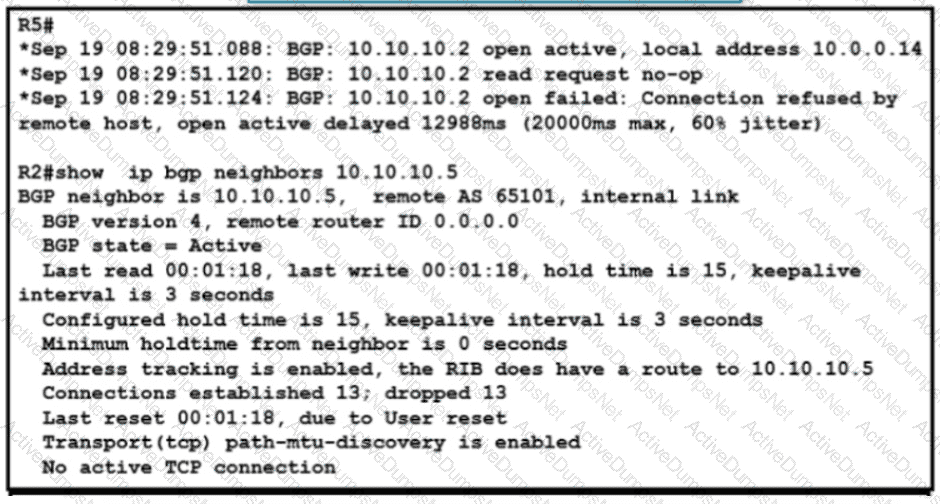
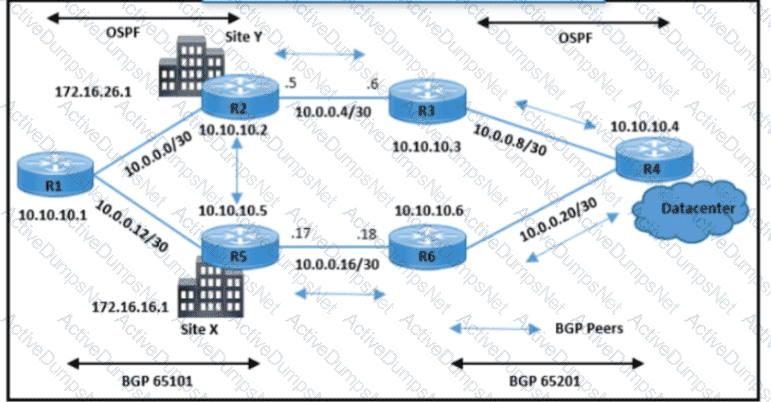
Refer to the exhibit A customer reported a failure and intermittent disconnection between two office buildings site X and site Y The network team finds that site X and site Y are exchanging email application traffic with the data center network Which configuration resolves the issue between site X and site Y?
A)

B)

C)

D)

Refer to the exhibit.
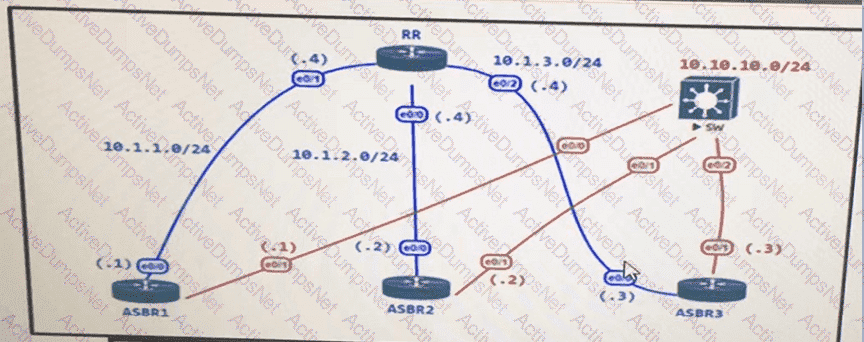
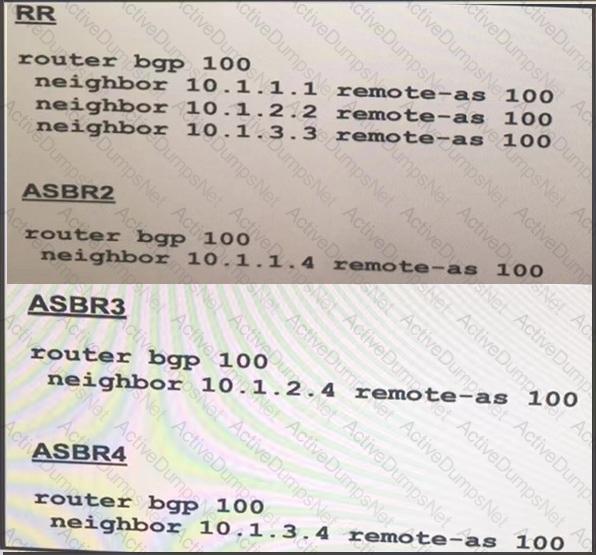
The administrator configured the network devise for end-to-end reachability, but the ASBRs are not propagation routes to each other. Which set of configuration resolves this issue?
A)

B)

C)

D)

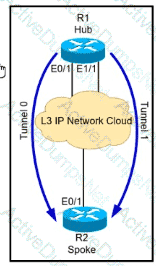
Refer to me exhibit. The hub and spoke are connected via two DMVPN tunnel interfaces The NHRP is configured and the tunnels are detected on the hub and the spoke Which configuration command adds an IPsec profile on both tunnel interfaces to encrypt traffic?

Refer to the exhibit. An engineer notices a connectivity problem between routers R1 and R2. The frequency of this problem is high during peak business hours. Which action resolves the issue?
Refer to the exhibit.
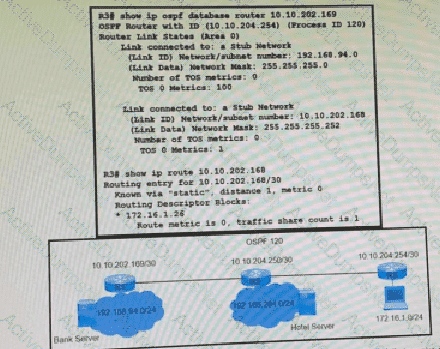
A network engineer finds that PC1 is accessing the hotel website to do the booking but fails to make payment. Which action resolves the issue?
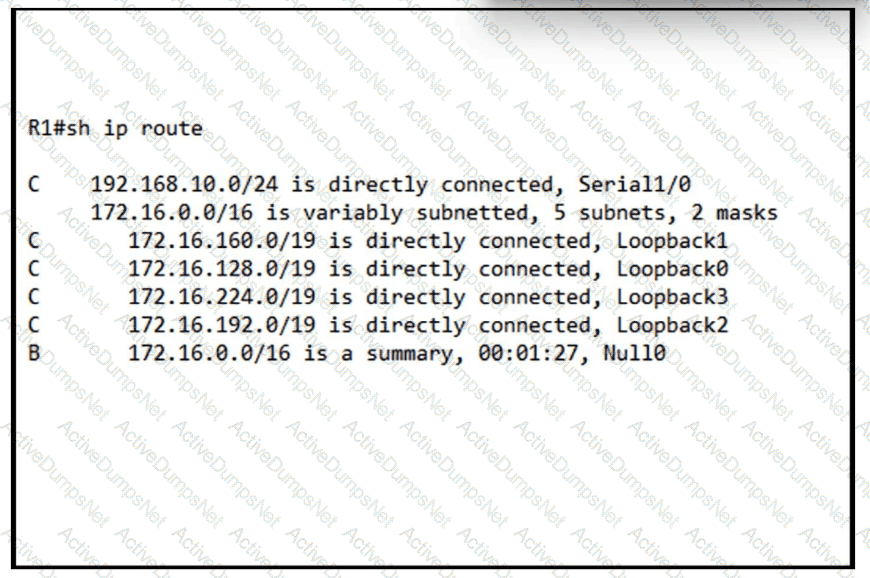
Refer to the exhibit. Which configuration advertises more specific routes to R1 without sending a BGP summary route?
An engineer configured routing between multiple OSPF domains and introduced a routing loop that caused network instability. Which action resolves the problem?
Refer to the exhibit.

Routers R1, R2, R3, and R4 use EIGRP However, traffic always prefers R1 to R5 backup links in nonfailure scenarios. Which configuration resolves the issue?
A)

B)

C)

D)

Which two components are required for MPLS Layer 3 VPN configuration? (Choose two)

Refer to the exhibit. After a security hardening was performed on a router, the administrator cannot access the command line of any remote device. Which action resolves the issue?
What is a function of BFD?
Which function does LDP provide in an MPLS topology?
Refer to the exhibit.

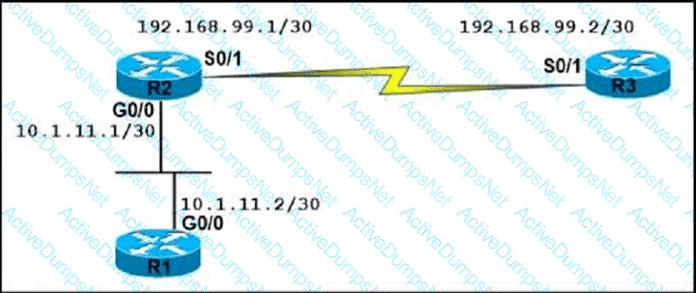
An OSPF neighbor relationship between R2 and R3 is showing stuck in EXCHANGE/EXSTART state. The neighbor is established between R1 and R2. The network engineer can ping from R2 to R3 and vice versa, but the
neighbor is still down. Which action resolves the issue?
Refer to the exhibit.
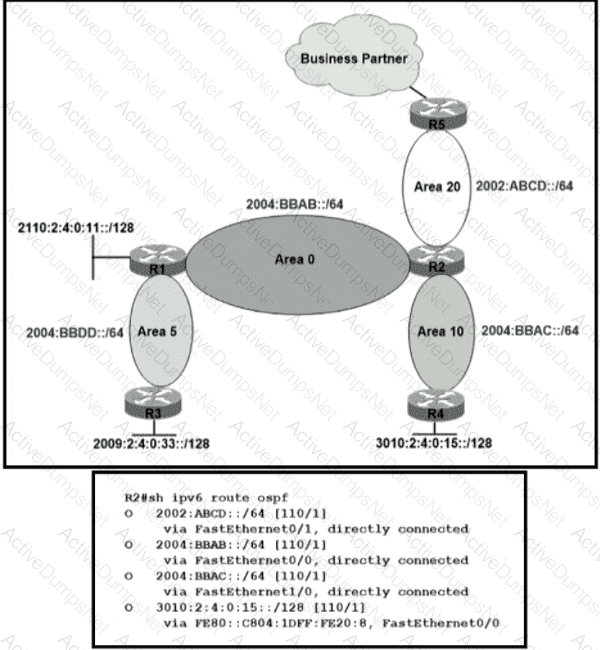
A network engineer applied a filter for LSA traffic on OSPFv3 interarea routes on the area 5 ABR to protect advertising the internal routes of area 5 to the business partner network. All other areas should receive the area 5 internal routes. After the respective route filtering configuration is applied on the ABR, area 5 routes are not visible on any of the areas. How must the filter list be applied on the ABR to resolve this issue?
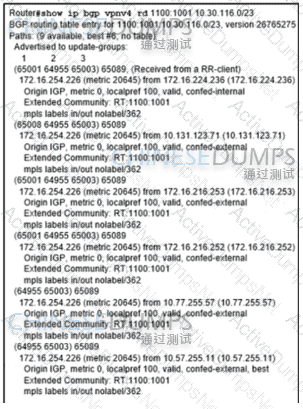
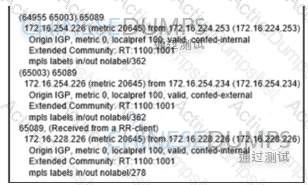
Refer to the exhibit. An engineer configured BGP and wants to select the path from 10.77.255.57 as the best path instead of current best path. Which action resolves the issue?
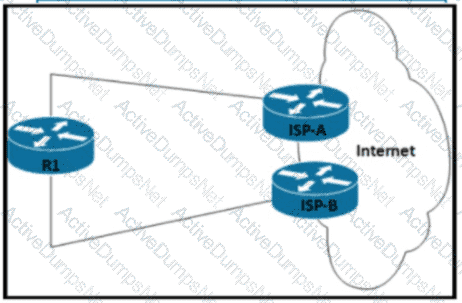
Refer to the exhibit. Router R1 peers with two ISPs using static routes to get to the internet. The requirement is that R1 must prefer ISP-A under normal circumstances and failover to ISP-B if the connectivity to ISP-A is lost. The engineer observes that R1 is load balancing traffic across the two ISPs Which action resolves the issue by sending traffic to ISP-A only with failover to ISP-B?
Refer to the exhibit.

When monitoring an IPv6 access list, an engineer notices that the ACL does not have any hits and is causing unnecessary traffic to pass through the interface Which command must be configured to resolve the issue?
What are two functions of IPv6 Source Guard? (Choose two.)
An engineer must configure a Cisco router to initiate secure connections from the router to other devices in the network but kept failing. Which two actions resolve the issue? (Choose two.)

Refer to the exhibit. R1 and R2 cannot establish an EIGRP adjacency. Which action establishes EIGRP adjacency?
Drag and drop the LDP features from the left onto the descriptions on the right

Refer to the exhibit.
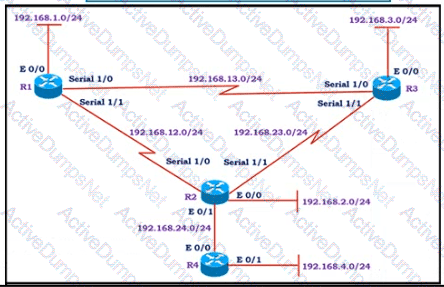
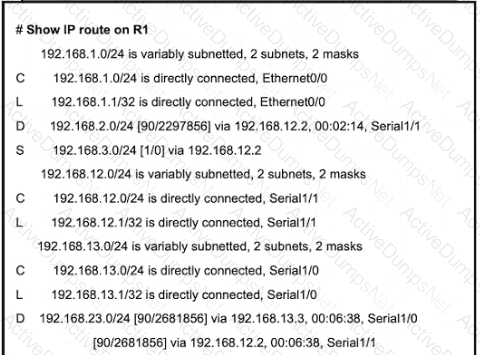
All the serial between R1, R2, and R3 have the Same bandwidth. User on the 192.168.1.0/24 network report slow response times while they access resource on network 192.168.3.0/24. When a traceroute is run on the path. It shows that the packet is getting forwarded via R2 to R3 although the link between R1 and R3 is still up. What must the network administrator to fix the slowness?
Refer to the exhibit.

The administrator successfully logs into R1 but cannot access privileged mode commands. What should be configured to resolve the issue?
When determining if a system is capable of support, what is the minimum time spacing required for a BFD control packet to receive once a control packet is arrived?
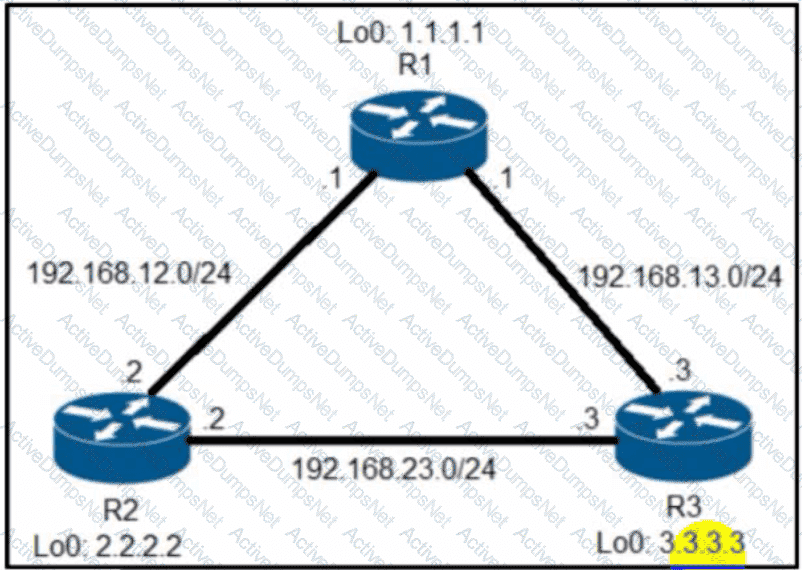
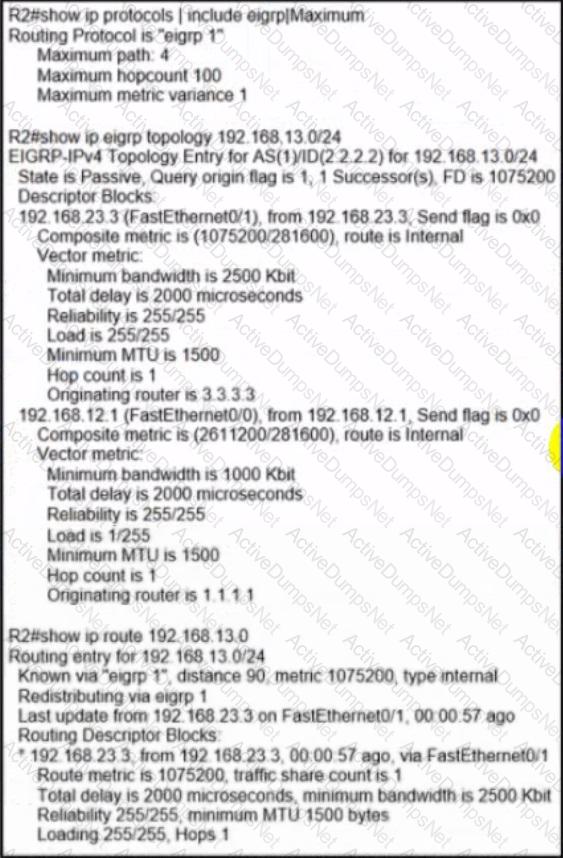
Refer to the exhibit. R2 has two paths to reach 192.168.13.0/24. but traffic is sent only through R3. Which action allows traffic to use both paths?
Refer to the exhibit.

Which action resolves the adjacency issue?
Refer to the exhibit.
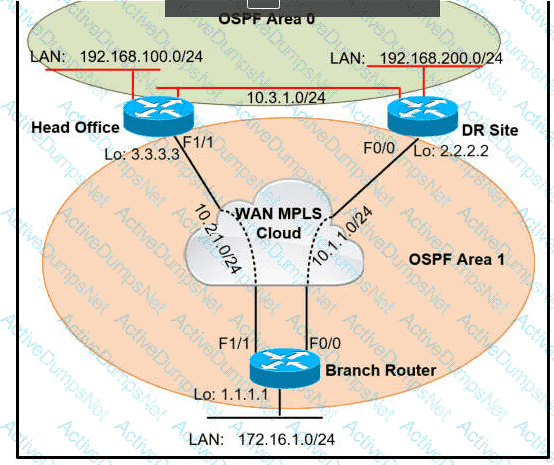
A network administrator reviews the branch router console log to troubleshoot the OSPF adjacency issue with the DR router. Which action resolves this issue?
What are two functions of MPLS Layer 3 VPNs? (Choose two.)
What are two purposes of using IPv4 and VPNv4 address-family configurations in a Layer 3 MPLS VPN? (Choose two.)
Refer to Exhibit.
A network administrator has successfully configured DMVPN topology between a hub and two spoke routers. Which two configuration commands should establish direct communications between spoke 1 and spoke 2 without going through the hub? (Choose two).
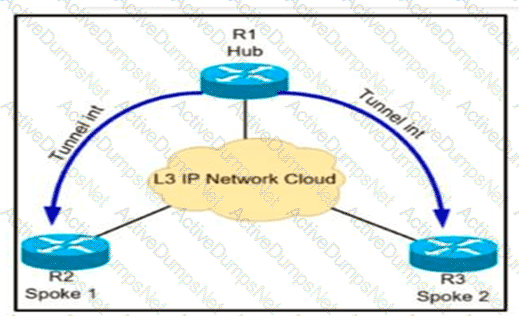
Refer to the exhibit.
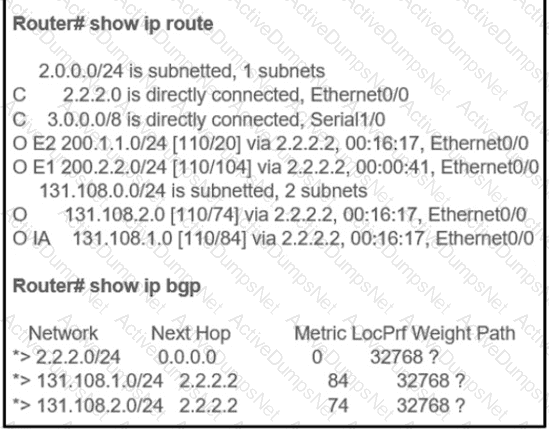
The OSPF routing protocol is redistributed into the BGP routing protocol, but not all the OSPF routes are distributed into BGP Which action resolves the issue?
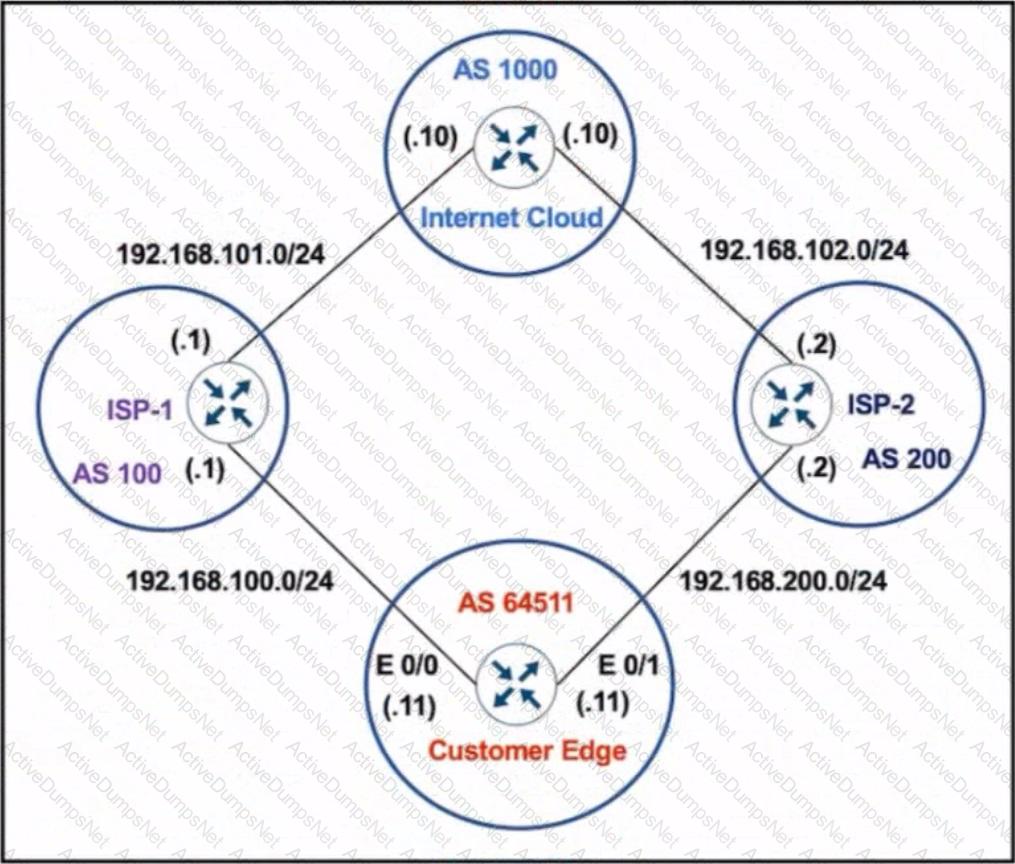
Refer to the exhibit. The network administrator has configured the Customer Edge router (AS 64511) to send only summarized routes toward ISP-1 (AS 100) and ISP-2 (AS 200).
router bgp 64511
network 172.16.20.0 mask 255.255.255.0
network 172.16.21.0 mask 255.255.255.0
network 172.16.22.0 mask 255.255.255.0
network 172.16.23.0 mask 255.255.255.0
aggregate-address 172.16.20.0 255.255.252.0
After this configuration. ISP-1 and ISP-2 continue to receive the specific routes and the summary route. Which configuration resolves the issue?
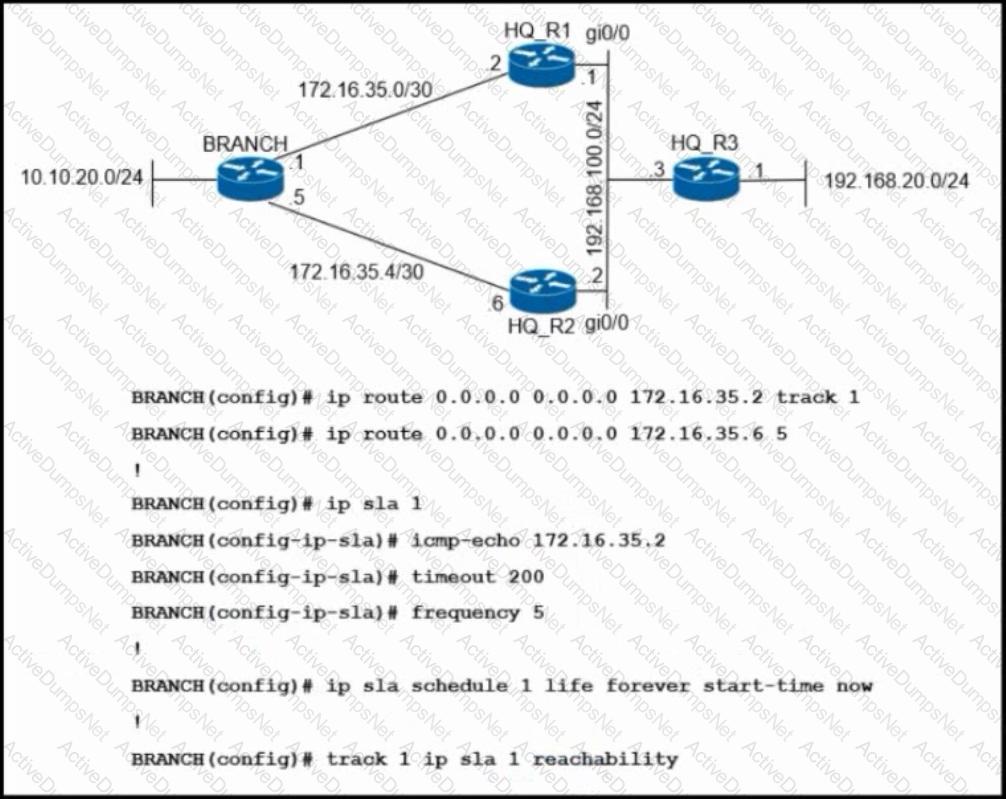
Refer to the exhibit. An engineer has successfully set up a floating static route from the BRANCH router to the HQ network using HQ_R1 as the primary default gateway When the g0/0 goes down on HQ_R1, the branch network cannot reach the HQ network 192.168.20.0/24. Which set of configurations resolves the issue?
What are two functions of LDP? (Choose two.)
Refer to the exhibit.
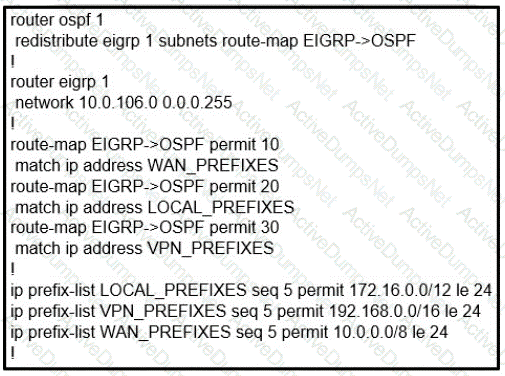
The network administrator configured redistribution on an ASBR to reach to all WAN networks but failed Which action resolves the issue?
Refer to the exhibit.
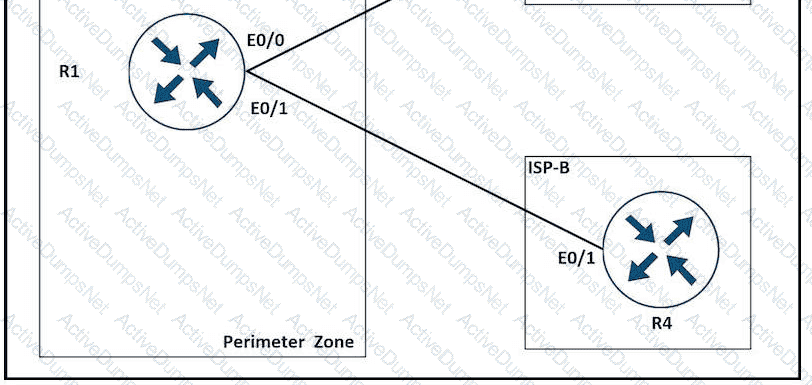
A network is under a cyberattack. A network engineer connected to R1 by SSH and enabled the terminal monitor via SSH session to find the source and destination of the attack. The session was flooded with messages, which made it impossible for the engineer to troubleshoot the issue. Which command resolves this issue on R1?
Exhibit:
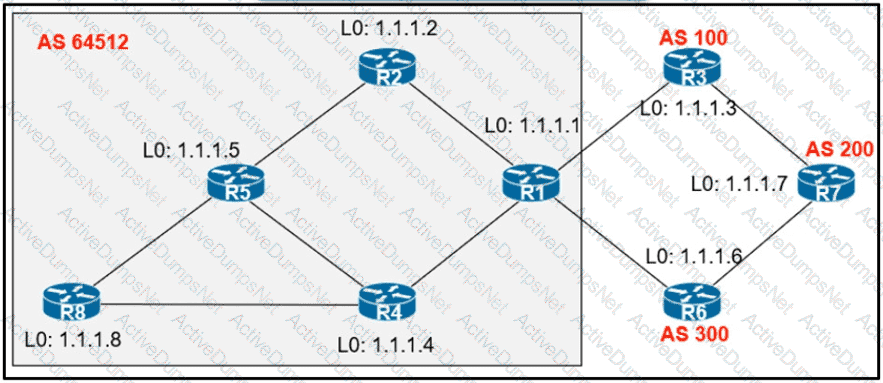
An engineer configured R2 and R5 as route reflectors and noticed that not all routes are sent to R1 to advertise to the eBGP peers. Which iBGP routers must be configured as route reflectors to advertise all routes to restore reachability across all networks?
Refer to Exhibit.
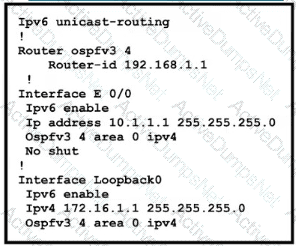
The network administrator configured the branch router for IPv6 on the E0/0 interface. The neighboring router is fully configured to meet requirements, but the neighbor relationship is not coming up. Which action fixes the problem on the branch router to bring the IPv6 neighbors up?
An engineer configured two routers connected to two different service providers using BGP with default attributes. One of the links is presenting high delay, which causes slowness in the network. Which BGP attribute must the engineer configure to avoid using the high-delay ISP link if the second ISP link is up?
Refer to the exhibit.
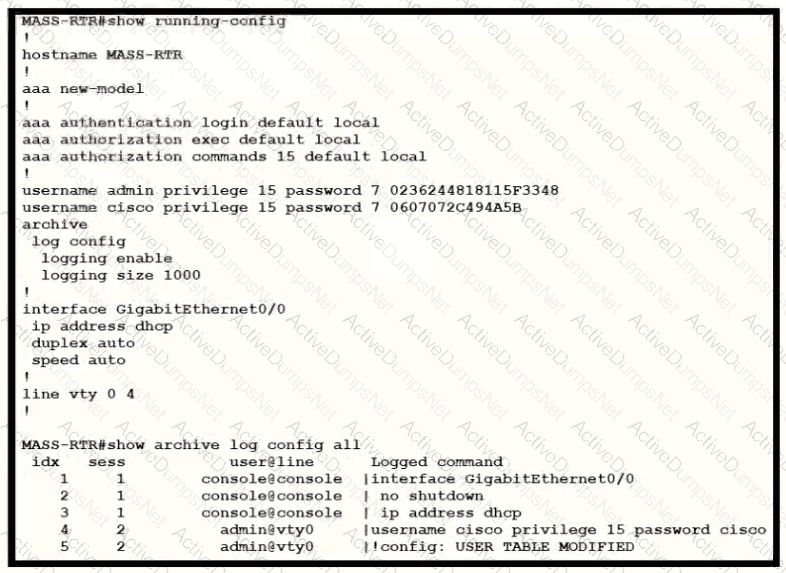
A client is concerned that passwords are visible when running this show archive log config all.
Which router configuration is needed to resolve this issue?
An engineer configured a DHCP server for Cisco IP phones to download its configuration from a TFTP server, but the IP phones failed to toad the configuration What must be configured to resolve the issue?
An engineer is troubleshooting on the console session of a router and turns on multiple debug commands. The console screen is filled with scrolling debug messages that none of the commands can be verified if entered correctly or display any output. Which action allows the engineer to see entered console commands while still continuing the analysis of the debug messages?
A customer reports to the support desk that they cannot print from their PC to the local printer id:401987778. Which tool must be used to diagnose the issue using Cisco DNA Center Assurance?
Refer to the exhibit.
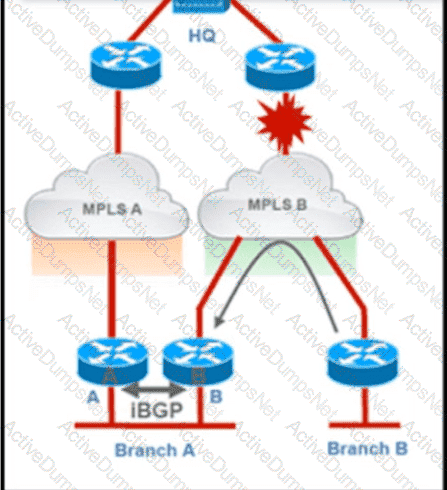
Troubleshoot and ensure that branch B only ever uses the MPLS B network to reach HQ. Which action achieves this requirement?
Refer to the exhibit.

The network administrator must mutually redistribute routes at the Chicago router to the LA and NewYork routers. The configuration of the Chicago router is this:

After the configuration, the LA router receives all the NewYork routes, but NewYork router does not receive any LA routes. Which set of configurations fixes the problem on the Chicago router?
A)

B)

C)

D)

How are MPLS Layer 3 VPN services deployed?
Refer to the exhibit.

An IT staff member comes into the office during normal office hours and cannot access devices through SSH Which action should be taken to resolve this issue?
Refer to the exhibit.
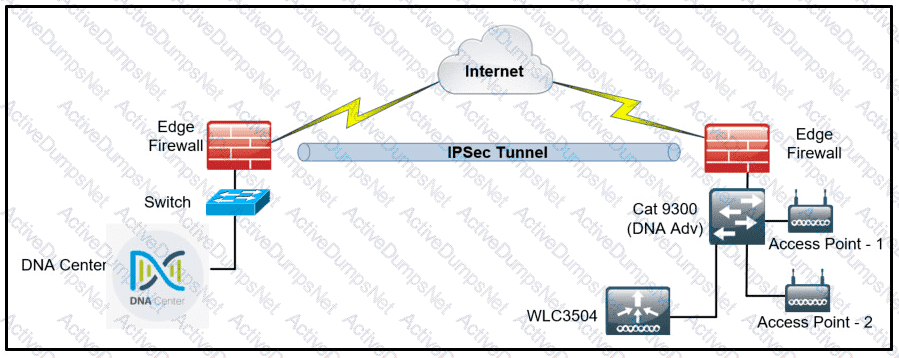
A network administrator is discovering a Cisco Catalyst 9300 and a Cisco WLC 3504 in Cisco DNA Center. The Catalyst 9300 is added successfully However the WLC is showing [ error "uncontactable" when the administrator tries to add it in Cisco DNA Center. Which action discovers WLC in Cisco DNA Center successfully?
An engineer configured SNMP notifications sent to the management server using authentication and encrypting data with DES. An error in the response PDU is received as "UNKNOWNUSERNAME. WRONGDIGEST". Which action resolves the issue?
Refer to Exhibit.
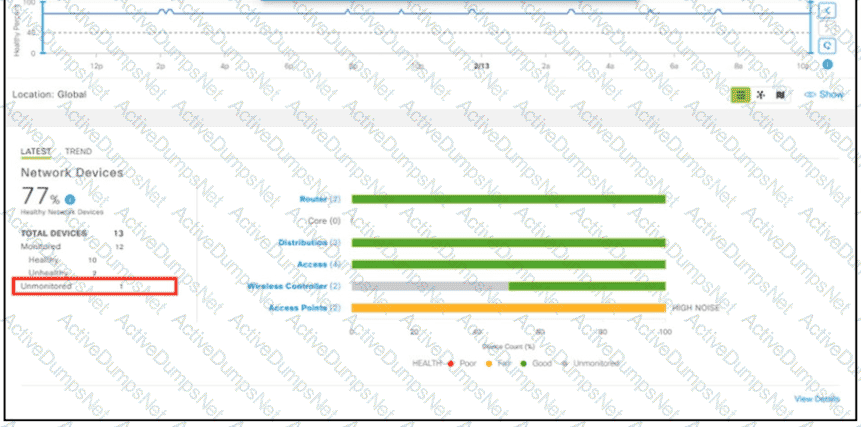
A network administrator added one router in the Cisco DNA Center and checked its discovery and health from the Network Health Dashboard. The network administrator observed that the router is still showing up as unmonitored. What must be configured on the router to mount it in the Cisco DNA Center?
Refer to the exhibit.

The R1 and R2 configurations are:
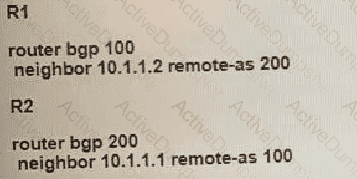
The neighbor is not coming up. Which two sets of configurations bring the neighbors up? (Choose two.)
Which configuration feature should be used to block rogue router advertisements instead of using the IPv6 Router Advertisement Guard feature?
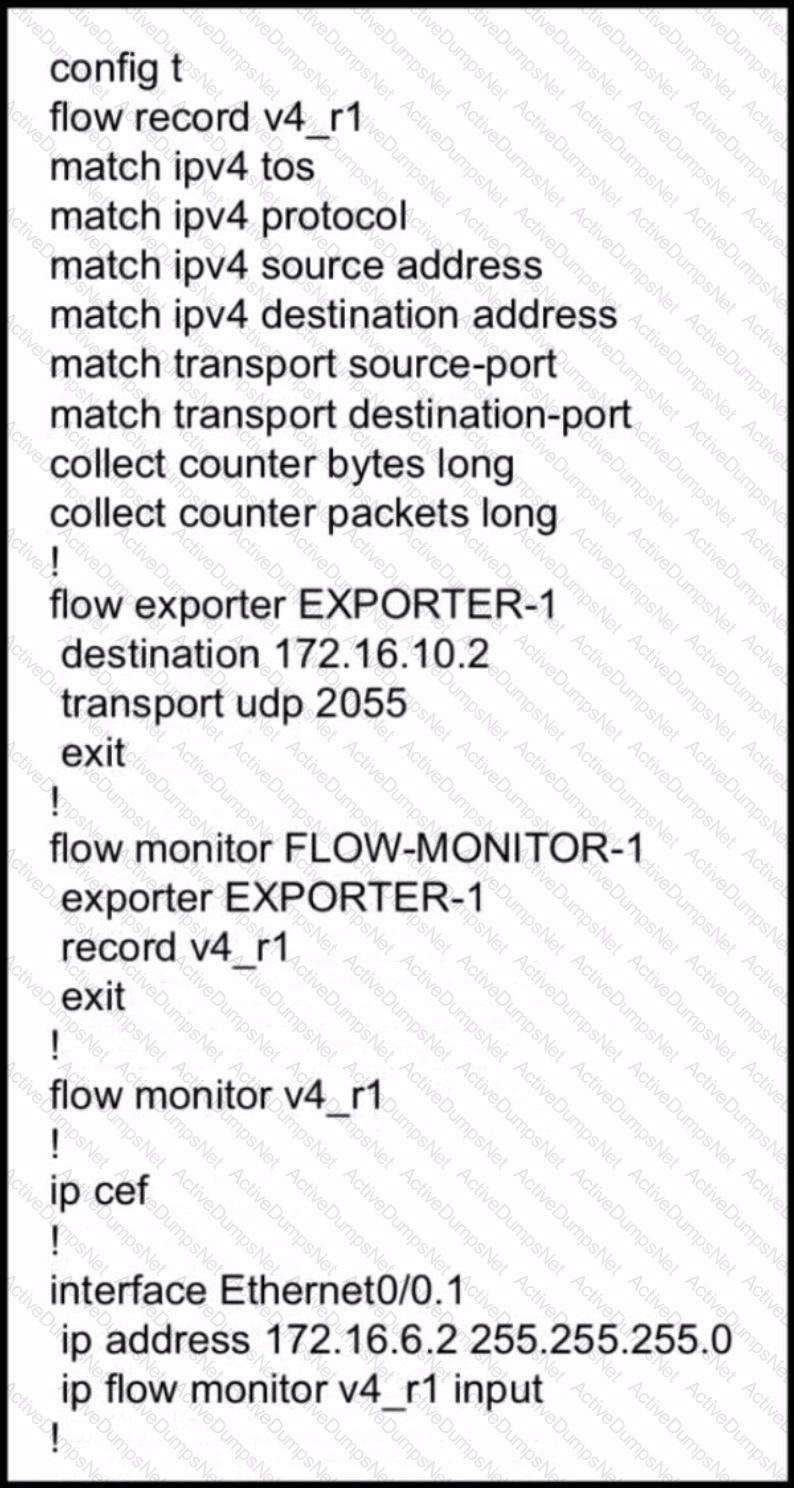
Refer to the exhibit. The remote server is failing to receive the NetFlow data Which action resolves the issue?
An engineer needs dynamic routing between two routers and is unable to establish OSPF adjacency. The output of the show ip ospf neighbor command shows that the neighbor state is EXSTART/EXCHANGE. Which action should be taken to resolve this issue?

Refer to the exhibit. A network administrator configured NTP on a Cisco router to get synchronized time for system and logs from a unified time source The configuration did not work as desired Which service must be enabled to resolve the issue?
Refer to the exhibit.
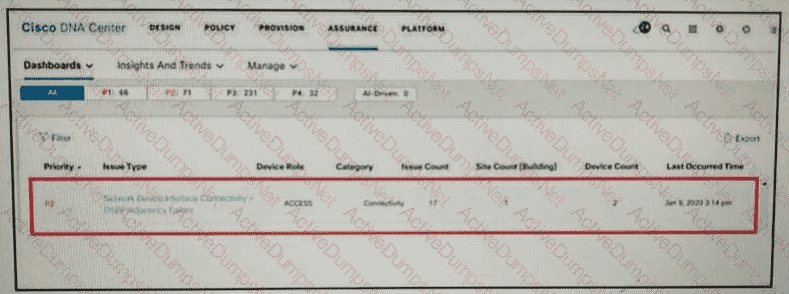
A network administrator is using the DNA Assurance Dashboard panel to troubleshoot an OSPF adjacency that failed between Edge_NYC interface GigabitEthernet1/3 with Neighbor Edge_SNJ. The administrator observes that the neighborship is stuck in exstart state. How does the administrator fix this issue?
Refer to the exhibit.

Which action resolves the failed authentication attempt to the router?
Refer to the exhibit.
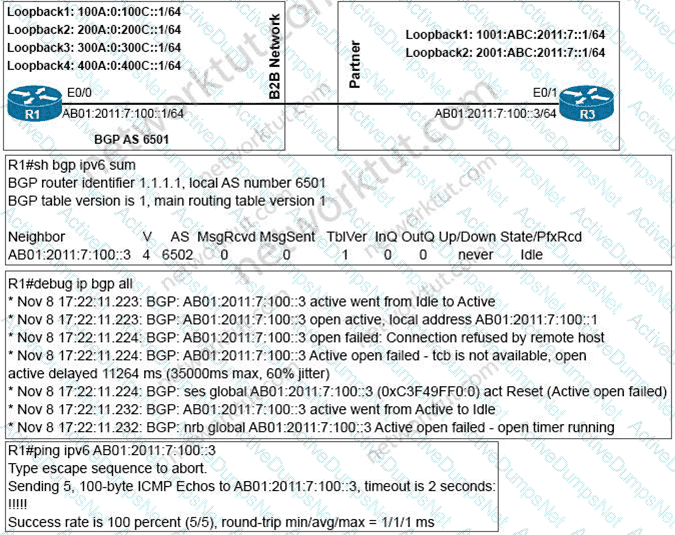

An engineer configured BGP between routers R1 and R3 The BOP peers cannot establish neighbor adjacency to be able to exchange routes. Which configuration resolves this issue?
Refer to the exhibit.
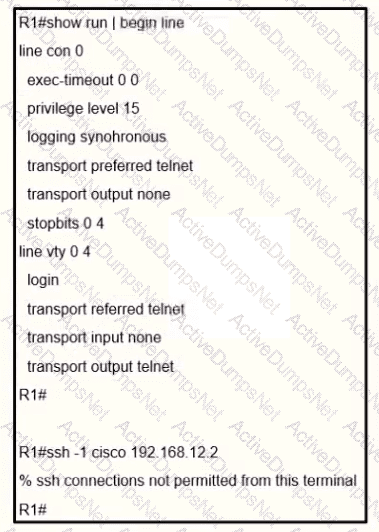
An engineer receives this error message when trying to access another router in-band from the serial interface connected to the console of R1. Which configuration is needed on R1 to resolve this issue?
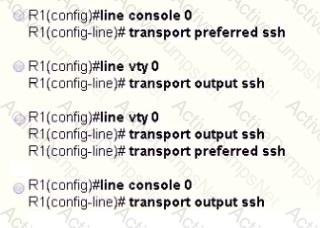
Refer to the exhibit.
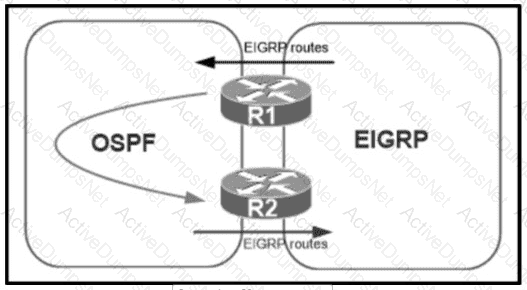
A network administrator configured mutual redistribution on R1 and R2 routers, which caused instability in the network. Which action resolves the issue?
When configuring Control Plane Policing on a router to protect it from malicious traffic, an engineer observes that the configured routing protocols start flapping on
that device. Which action in the Control Plane Policy prevents this problem in a production environment while achieving the security objective?
What does the PE router convert the Ipv4 prefix to within an MPLS VPN?
Which two components are needed for a service provider to utilize the LVPN MPLS application? (Choose two.)
Refer to the exhibit.
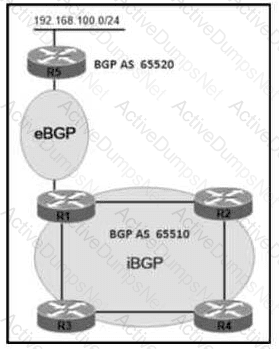
AS65510 iBGP is configured for directly connected neighbors. R4 cannot ping or traceroute network 192 168.100.0/24 Which action resolves this issue?
Refer to the exhibit.
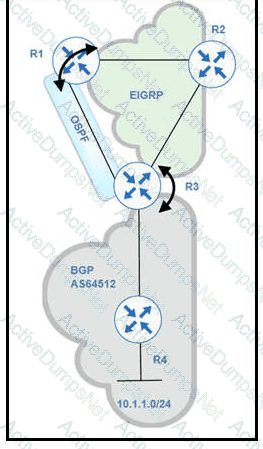
BGP and EIGRP are mutually redistributed on R3, and EIGRP and OSPF are mutually redistributed on R1. Users report packet loss and interruption of service to applications hosted onthe 10.1.1.0724 prefix. An engineer tested the link from R3 to R4 with no packet loss present but has noticed frequent routing changes on R3 when running the debug ip route command. Which action stabilizes the service?
Clients on ALS2 receive IPv4 and IPv6 addresses but clients on ALS1 receive only IPv4 addresses and not IPv6 addresses. Which action on DSW1 allows clients on ALS1 to receive IPv6 addresses?
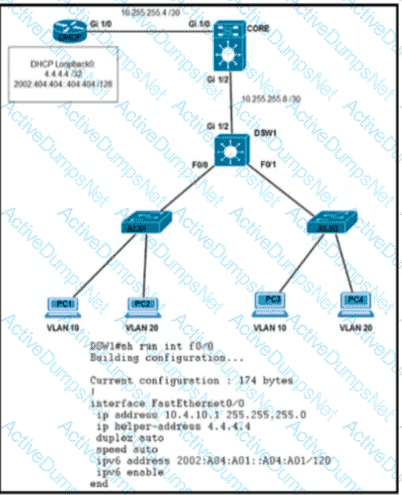
Refer to the exhibit.
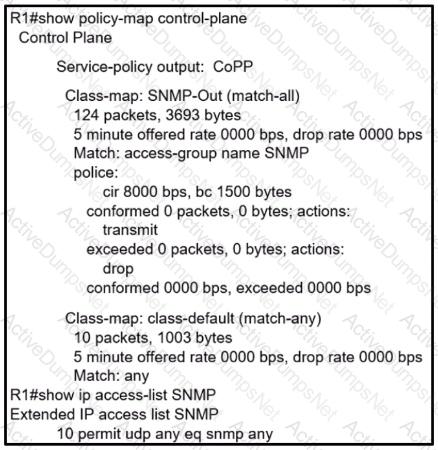
R1 is being monitored using SNMP and monitoring devices are getting only partial information. What action should be taken to resolve this issue?
Refer to Exhibit.
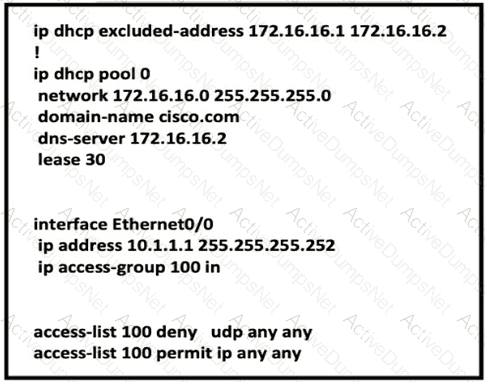
Which two configurations allow clients to get dynamic ip addresses assigned?
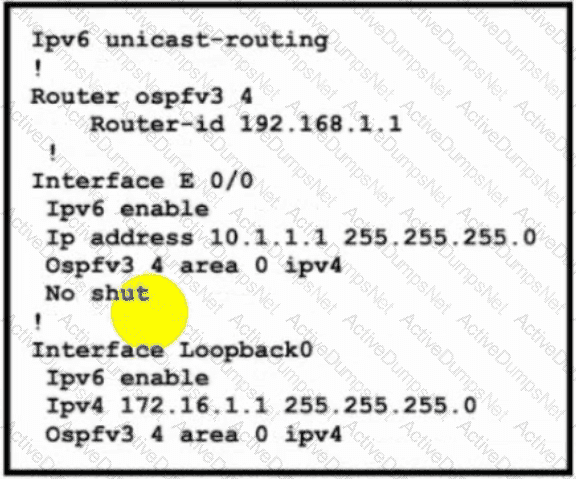
Refer to the exhibit. The network administrator configured the branch router for IPv6 on the E 0/0 interface The neighboring router is fully configured to meet requirements, but the neighbor relationship is not coming up. Which action fixes the problem on the branch router to bring the IPv6 neighbors up?
An engineer configured access list NON-CISCO in a policy to influence routes
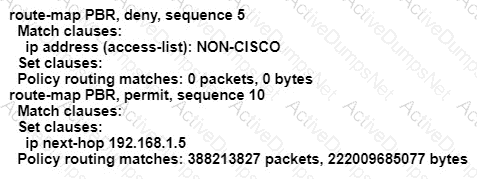
What are the two effects of this route map configuration? (Choose two.)
Which Ipv6 first-hop security feature helps to minimize denial of service attacks?
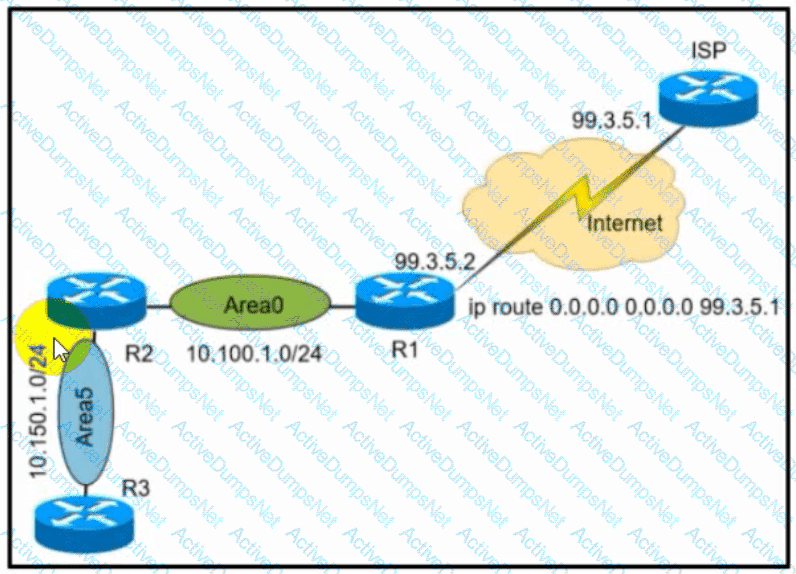
Refer to the exhibit. A network administrator redistributed the default static route into OSPF toward all internal routers to reach to Internet. Which set of commands restores reachability to the Internet by internal routers?
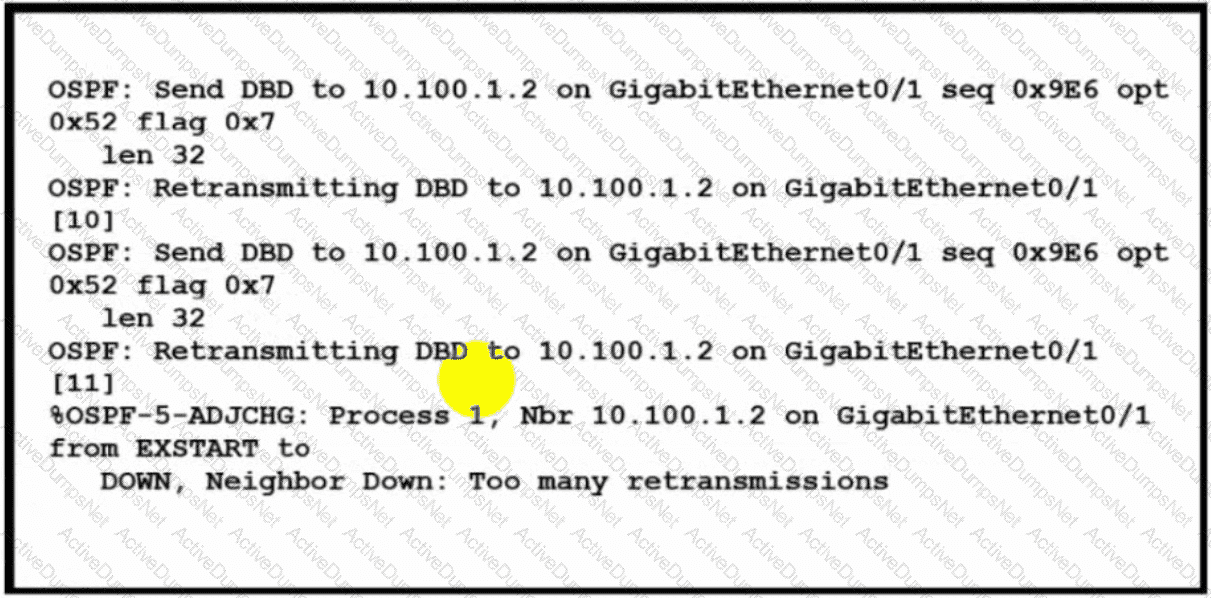
Refer to the exhibit. The OSPF neighbor relationship is not coming up What must be configured to restore OSPF neighbor adjacency?
Exhibit:
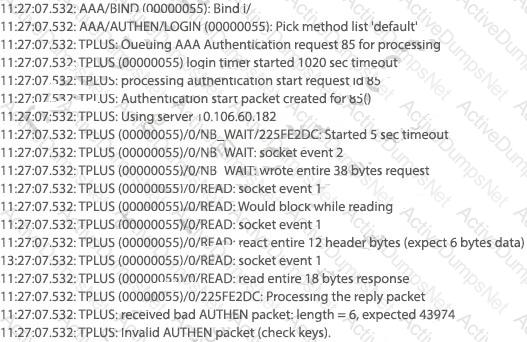
Which action resolves the authentication problem?
Which feature drops packets if the source address is not found in the snooping table?
Refer to the exhibit.
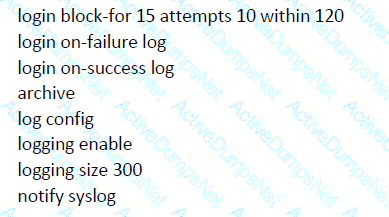

The administrator can see the traps for the failed login attempts, but cannot see the traps of successful login attempts. What command is needed to resolve the issue?
Refer to the exhibit.
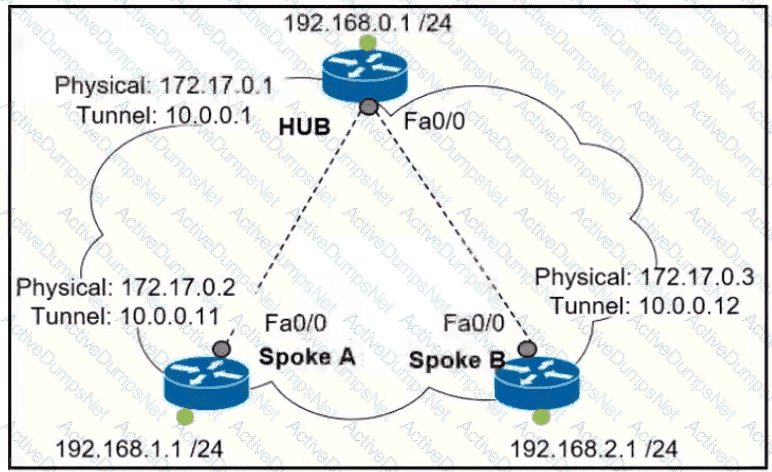
Which interface configuration must be configured on the HUB router to enable MVPN with mGRE mode?
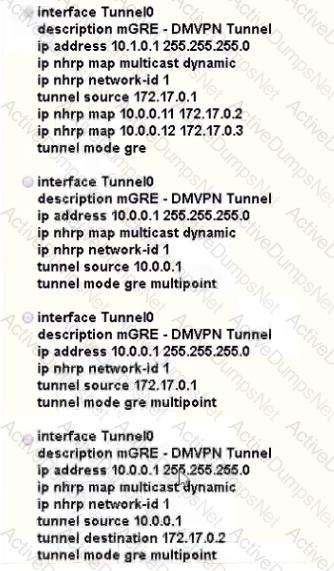
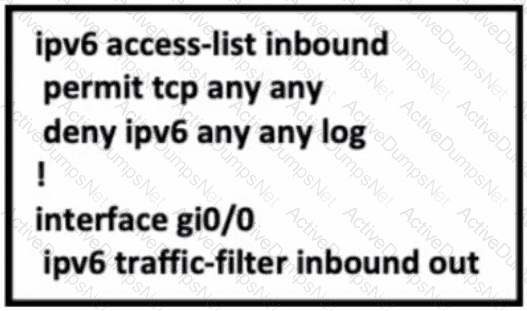
Refer to the exhibit. A network administrator configured an IPv6 access list to allow TCP return traffic only, but it is not working as expected. Which changes resolve this issue?
What statement about route distinguishes in an MPLS network is true?
Which statement about route distinguishers in an MPLS network is true?
Which command displays the IP routing table information that is associated with VRF-Lite?
Refer to the exhibit.

An engineer is trying to connect to a device with SSH but cannot connect. The engineer connects by using the console and finds the displayed output when troubleshooting. Which command must be used in configuration mode to enable SSH on the device?
A network engineer is investigating a flapping (up/down) interface issue on a core switch that is synchronized to an NTP server. Log output currently does not show the time of the flap. Which command allows the logging on the switch to show the time of the flap according to the clock on the device?
Refer to the exhibit.
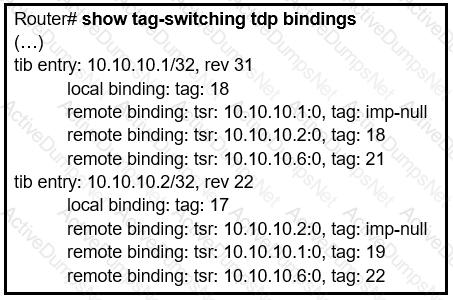
What does the imp-null tag represent in the MPLS VPN cloud?
An engineer configured a company’s multiple area OSPF head office router and Site A cisco
routers with VRF lite. Each site router is connected to a PE router of an MPLS backbone.

After finishing both site router configurations, none of the LSA 3,4 5, and 7 are installed at Site A router. Which configuration resolves this issue?
Refer to the exhibit.
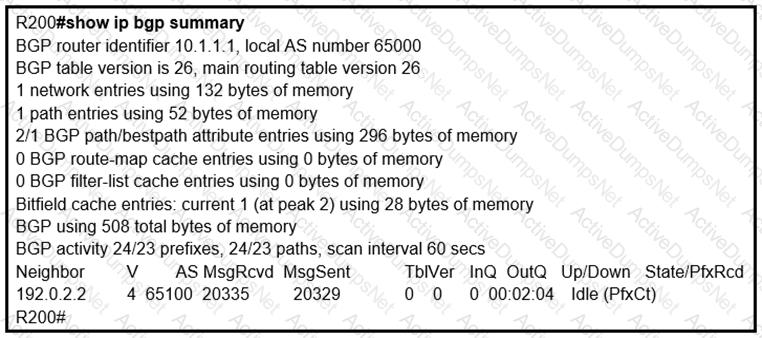
In which circumstance does the BGP neighbor remain in the idle condition?
During the maintenance window an administrator accidentally deleted the Telnet-related
configuration that permits a Telnet connection from the inside network (Eth0/0) to the outside of the networking between Friday – Sunday night hours only. Which configuration resolves the issue?
A)
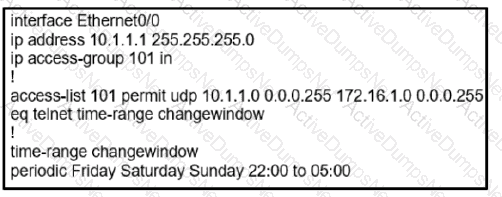
B)
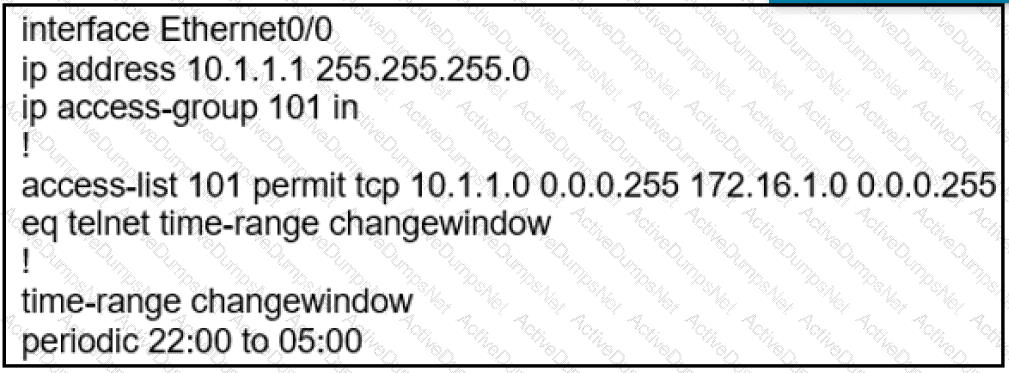
C)
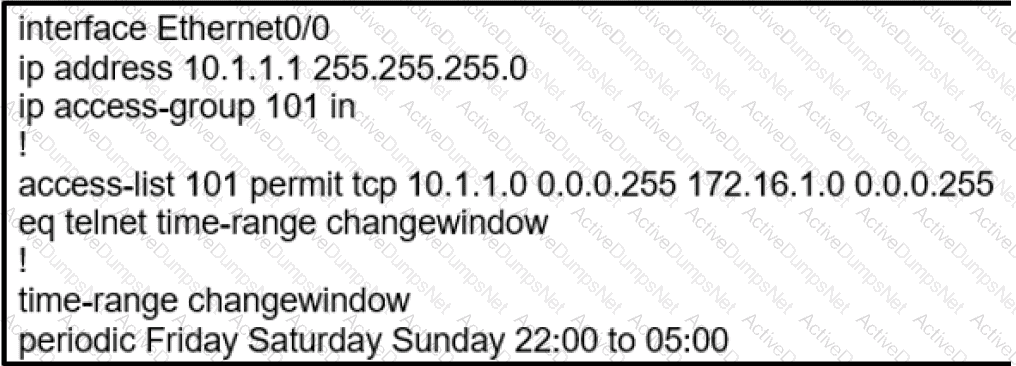
D)

Which statement about IPv6 ND inspection is true?
Drag and drop the SNMP attributes in Cisco IOS devices from the left onto the correct SNMPv2c or SNMPV3 categories on the right.
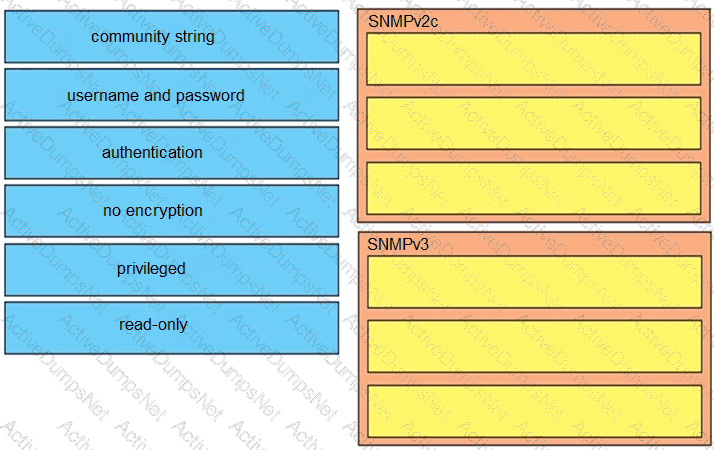
While working with software images, an engineer observes that Cisco DNA Center cannot upload its software image directly from the device. Why is the image not uploading?
An engineer configured a leak-map command to summarize EIGRP routes and advertise specifically loopback 0 with an IP of 10.1.1.1.255.255.255.252 along with the summary route. After finishing configuration, the customer complained not receiving summary route with specific loopback address. Which two configurations will fix it? (Choose two.)

An engineer is trying to copy an IOS file from one router to another router by using TFTP. Which two actions are needed to allow the file to copy? (Choose two.)
Refer to the exhibit.
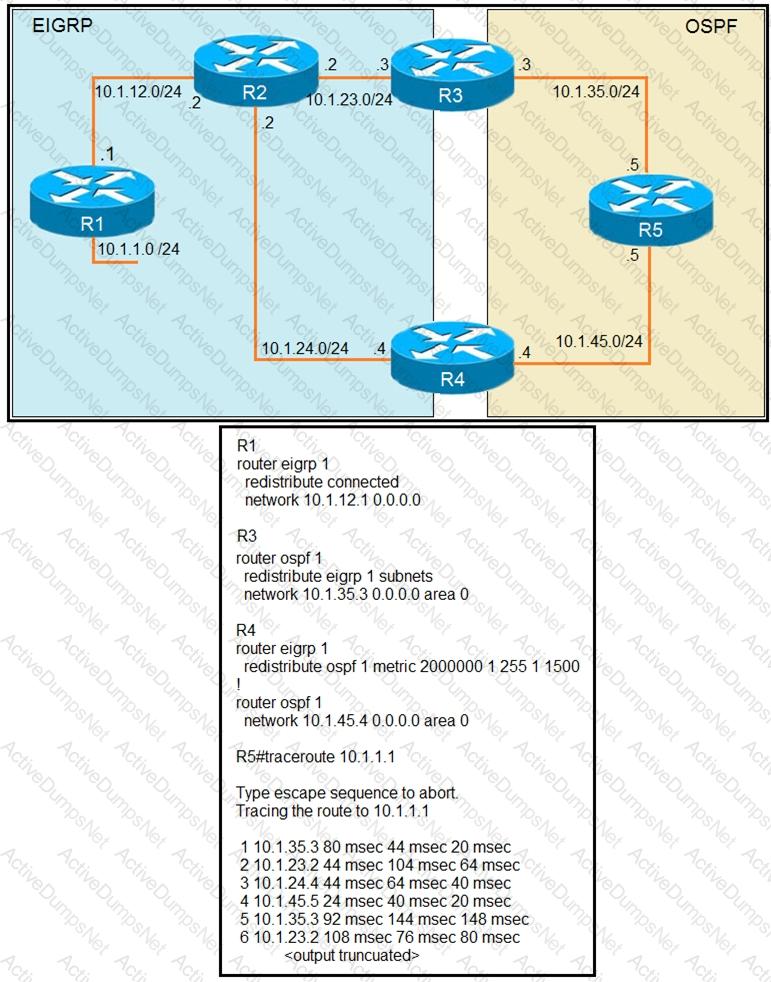
The output of the trace route from R5 shows a loop in the network. Which configuration
prevents this loop?
A)
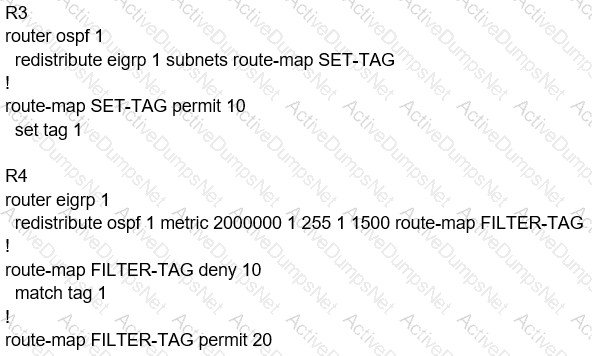
B)
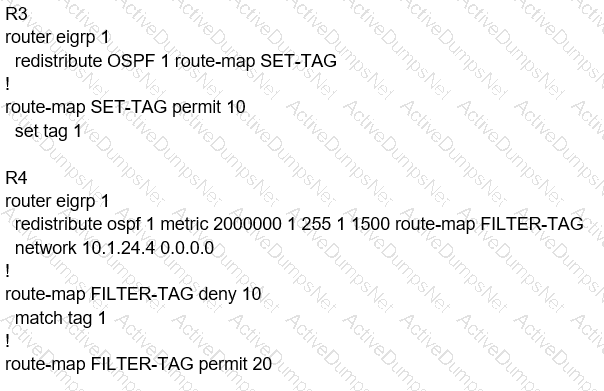
C)
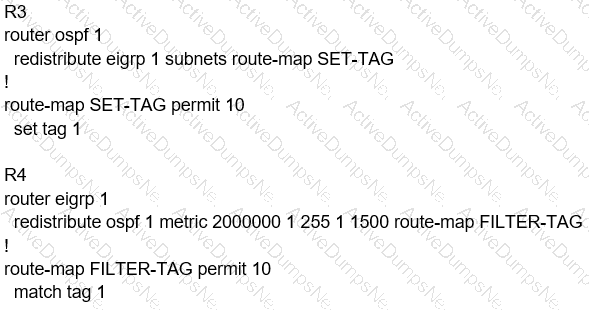
D)
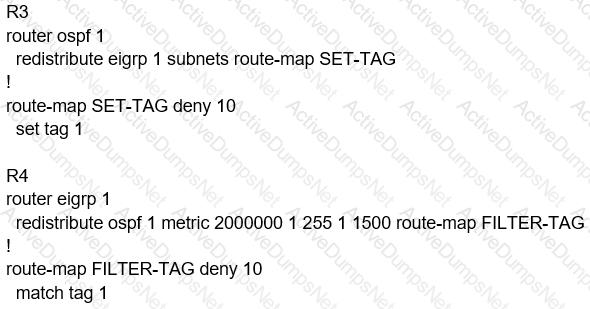
Refer to the exhibit.
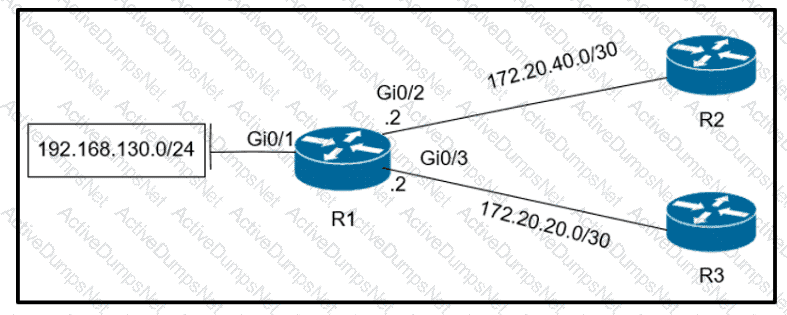
Which configuration configures a policy on R1 to forward any traffic that is sourced from
the 192.168.130.0/24 network to R2?
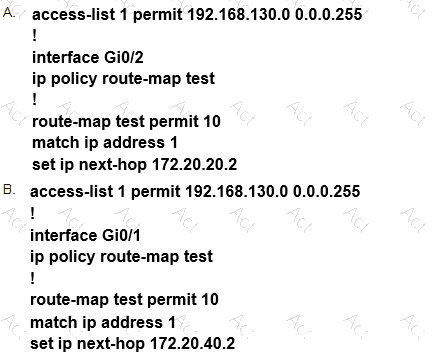
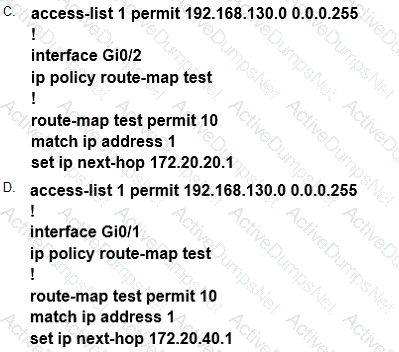
Drag and drop the MPLS VPN concepts from the left onto the correct descriptions on the right.
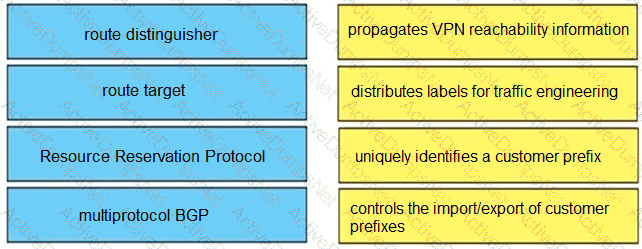
Which protocol does VRF-Lite support?
Drag and drop the OSPF adjacency states from the left onto the correct descriptions on the right.
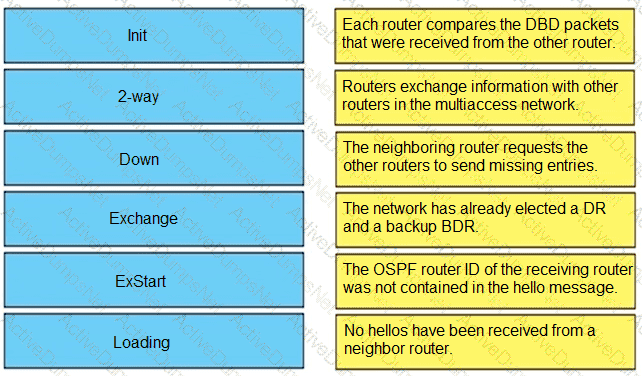
Which command allows traffic to load-balance in an MPLS Layer 3 VPN configuration?
Refer to the exhibit.
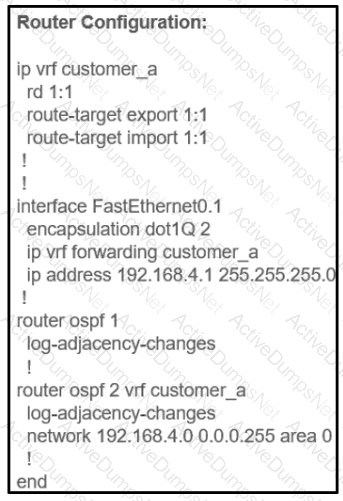
The network administrator configured VRF lite for customer A. The technician at the remote site misconfigured VRF on the router. Which configuration will resolve connectivity for both sites of customer_a?
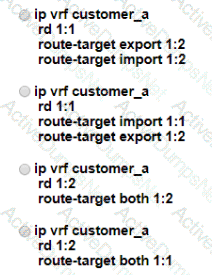
Drag and drop the MPLS VPN device types from me left onto the definitions on the right.

Which two statements about redistributing EIGRP into OSPF are true? (Choose two)
What is a limitation of IPv6 RA Guard?
Refer to the exhibit.

Network operations cannot read or write any configuration on the device with this configuration from the operations subnet. Which two configurations fix the issue? (Choose two.)
Refer to the exhibit.
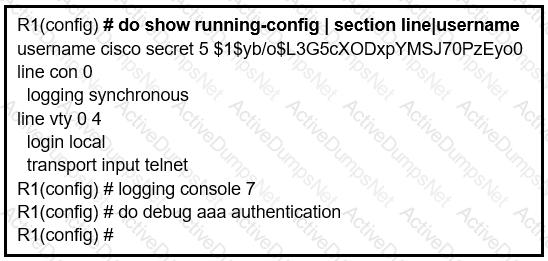
An administrator that is connected to the console does not see debug messages when
remote users log in. Which action ensures that debug messages are displayed for remote logins?
Refer to the exhibit.
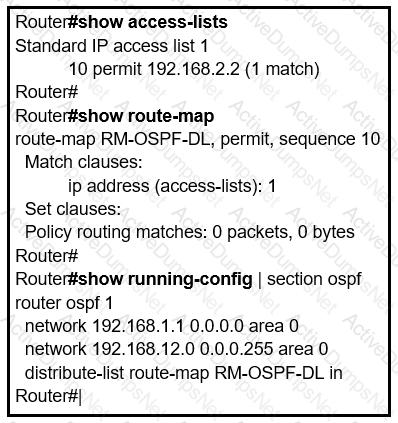
An engineer is trying to block the route to 192.168.2.2 from the routing table by using the
configuration that is shown. The route is still present in the routing table as an OSPF route. Which action blocks the route?
Refer to the exhibit.
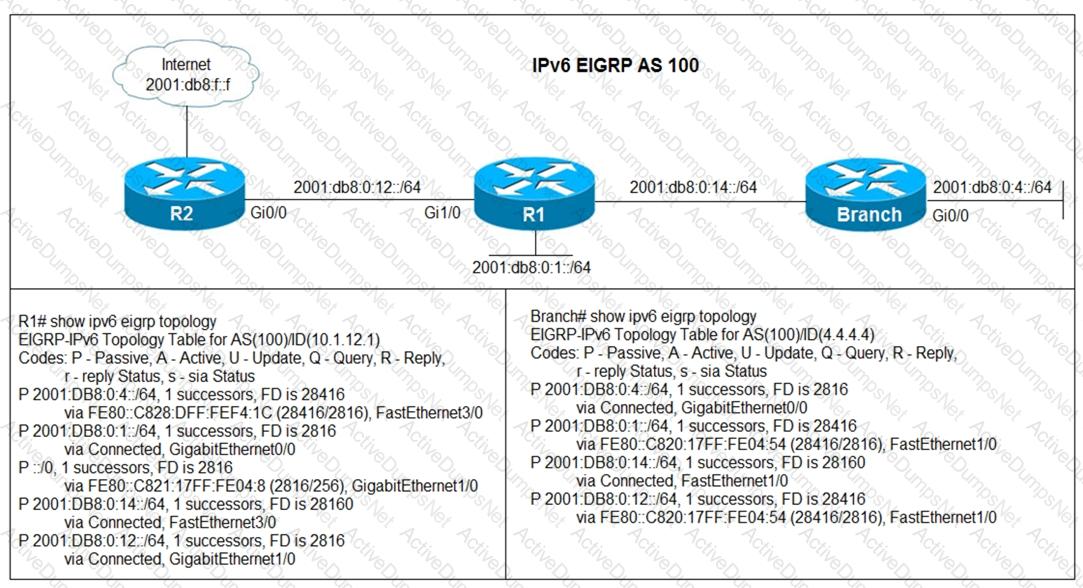
Users in the branch network of 2001:db8:0:4::/64 report that they cannot access the Internet. Which command is issued in IPv6 router EIGRP 100 configuration mode to solve this issue?
Which two statements about VRF-Lite configurations are true? (Choose two.)
Refer to the exhibit.

Which configuration denies Telnet traffic to router 2 from 198A:0:200C::1/64?
A)

B)

C)

D)

What is an advantage of using BFD?
Refer to the exhibit.
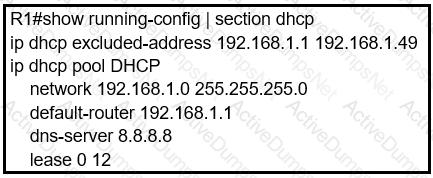
Users report that IP addresses cannot be acquired from the DHCP server. The DHCP
server is configured as shown. About 300 total nonconcurrent users are using this DHCP server, but none of them are active for more than two hours per day. Which action fixes the issue within the current resources?
Which list defines the contents of an MPLS label?
Refer to the exhibit.

An engineer has configured DMVPN on a spoke router. What is the WAN IP address of another spoke router within the DMVPN network?
Refer to the following output:
Router#show ip nhrp detail
10.1.1.2/8 via 10.2.1.2, Tunnel1 created 00:00:12, expire 01:59:47
TypE. dynamic, Flags: authoritative unique nat registered used
NBMA address: 10.12.1.2
What does the authoritative flag mean in regards to the NHRP information?
An engineer configured a leak-map command to summarize EIGRP routes and advertise specifically loopback 0 with an IP of 10.1.1.1.255.255.255.252 along with the summary route. After finishing configuration, the customer complained not receiving summary route with specific loopback address. Which two configurations will fix it? (Choose two.)

Refer to the exhibit.
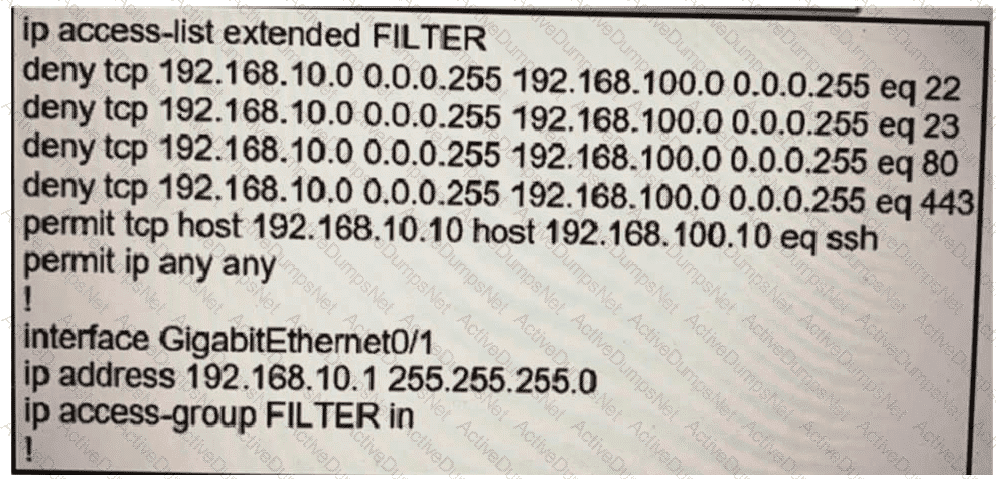
The ACL is placed on the inbound Gigabit 0/1 interface of the router. Host
192.168.10.10cannot SSH to host 192.168.100.10 even though the flow is permitted. Which action
resolves the issue without opening full access to this router?
Refer to the exhibit.
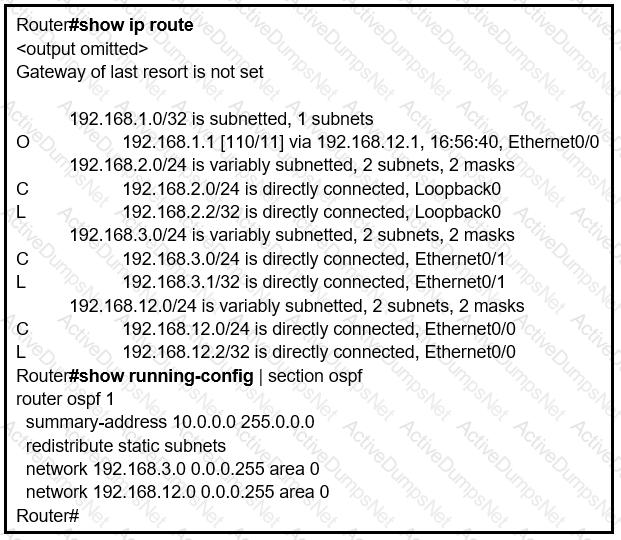
An engineer is trying to generate a summary route in OSPF for network 10.0.0.0/8, but the
summary route does not show up in the routing table. Why is the summary route missing?
Refer to the exhibit.
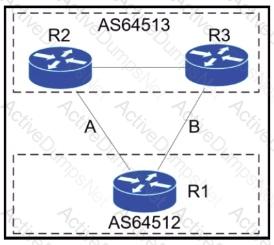
A network engineer for AS64512 must remove the inbound and outbound traffic from link A during maintenance without closing the BGP session so that there ............ a backup link over link A toward the ASN. Which BGP configuration on R1 accomplishes this goal?
A)
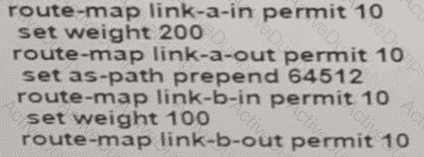
B)
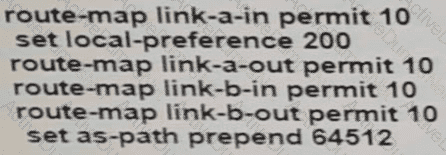
C)

D)
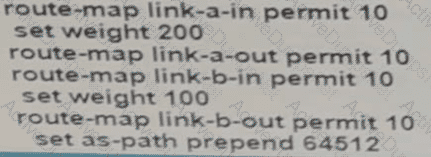
What is an advantage of using BFD?
Which protocol does VRF-Lite support?
Refer the exhibit.
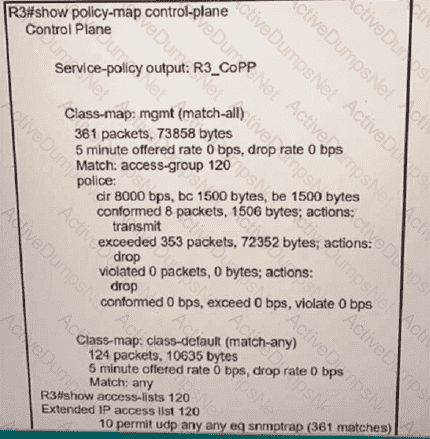
Which action resolves intermittent connectivity observed with the SNMP trap
packets?
Refer to the exhibits.
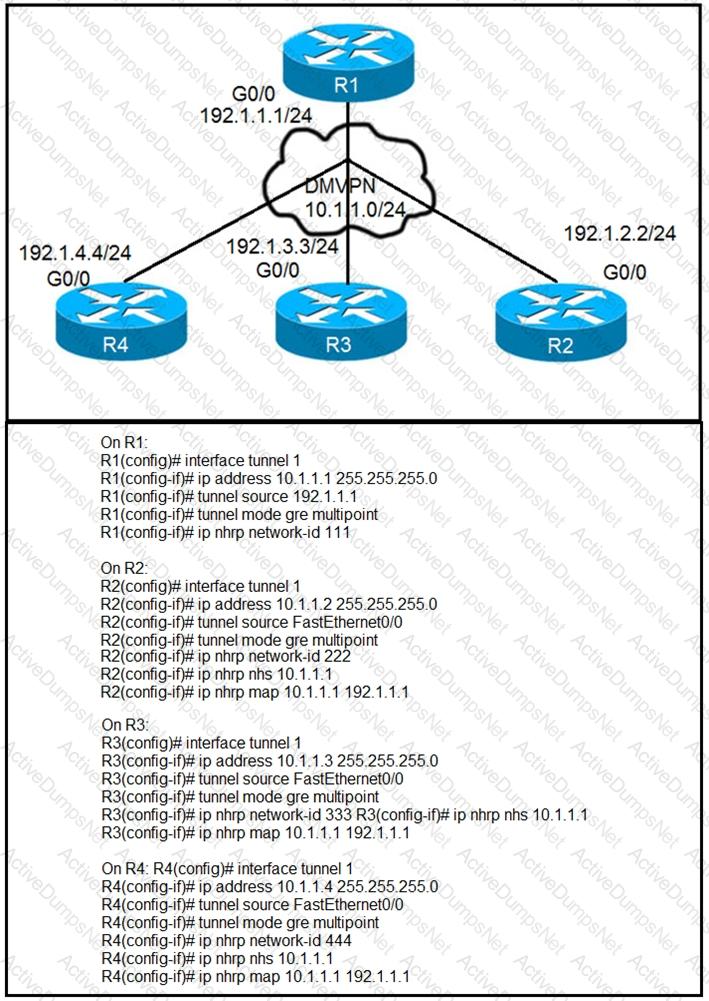
Phase-3 tunnels cannot be established between spoke-to-spoke in DMVPN. Which two
commands are missing? (Choose two.)
Which statement about IPv6 RA Guard is true?
Which command allows traffic to load-balance in an MPLS Layer 3 VPN configuration?
When provisioning a device in Cisco DNA Center, the engineer sees the error message “Cannot select the device. Not compatible with template”.
What is the reason for the error?
Which command displays the IP routing table information that is associated with VRF-Lite?
An engineer configured the wrong default gateway for the Cisco DNA Center enterprise interface during the install. Which command must the engineer run to correct the configuration?
Refer to the following output:
Router#show ip nhrp detail
10.1.1.2/8 via 10.2.1.2, Tunnel1 created 00:00:12, expire 01:59:47
TypE. dynamic, Flags: authoritative unique nat registered used
NBMA address: 10.12.1.2
What does the authoritative flag mean in regards to the NHRP information?
Refer to the exhibit.
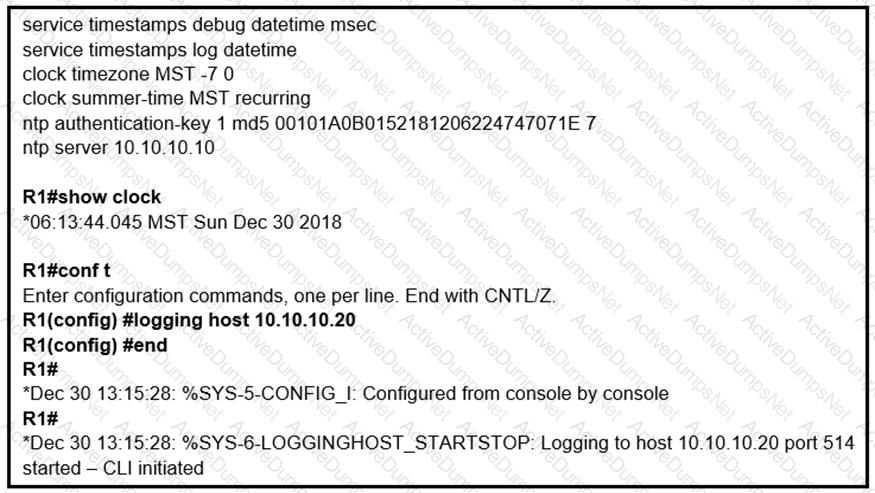
An administrator noticed that after a change was made on R1, the timestamps on the system logs did not match the clock. What is the reason for this error?
Which protocol does MPLS use to support traffic engineering?

Refer to the exhibit. an engineer is trying to get 192.168.32.100 forwarded through 10.1.1.1, but it was forwarded through 10.1.1.2. What action forwards the packets through 10.1.1.1?
An engineer is configuring a network and needs packets to be forwarded to an interface for any destination address that is not in the routing table. What should be configured to accomplish this task?
Refer to the exhibit.
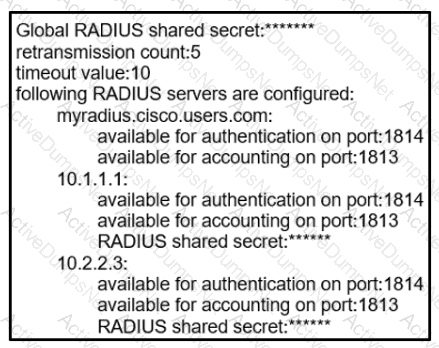
AAA server 10.1.1.1 is configured with the default authentication and accounting settings, but the switch cannot communicate with the server Which action resolves this issue?
Which configuration adds an IPv4 interface to an OSPFv3 process in OSPFv3 address family configuration?
Which statement about MPLS LDP router ID is true?
After some changes in the routing policy, it is noticed that the router in AS 45123 is being used as a transit AS router for several service provides. Which configuration ensures that the branch router in AS 45123 advertises only the local networks to all SP neighbors?
A)

B)

C)

D)

Drag and drop the operations from the left onto the locations where the operations are performed on the right.
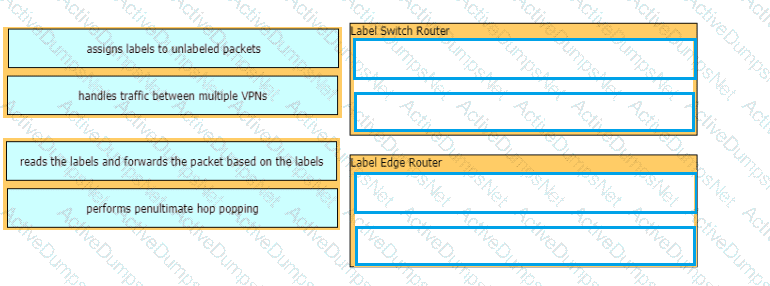
What is a prerequisite for configuring BFD?
Which configuration adds an IPv4 interface to an OSPFv3 process in OSPFv3 address family configuration?
Drag and Drop the IPv6 First-Hop Security features from the left onto the definitions on the right.
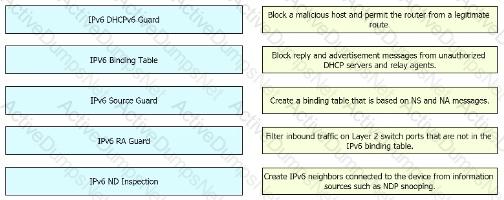
Drag and drop the MPLS terms from the left onto the correct definitions on the right.
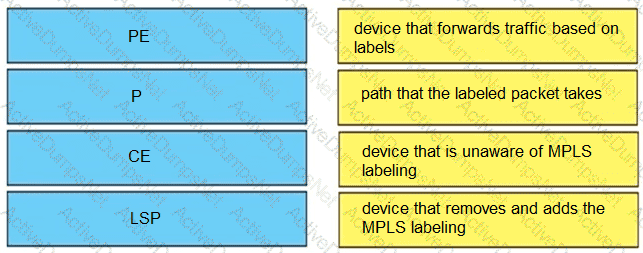
Which command is used to check IP SLA when an interface is suspected to receive lots of traffic with options?
Refer to the exhibit.

An engineer is trying to connect to a device with SSH but cannot connect. The engineer connects by using the console and finds the displayed output when troubleshooting. Which command must be used in configuration mode to enable SSH on the device?

 A black screen with white text AI-generated content may be incorrect.
A black screen with white text AI-generated content may be incorrect.
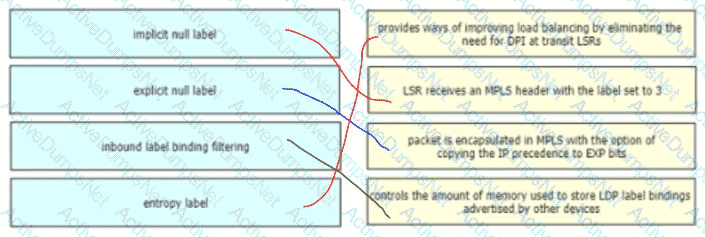 Diagram Description automatically generated
Diagram Description automatically generated



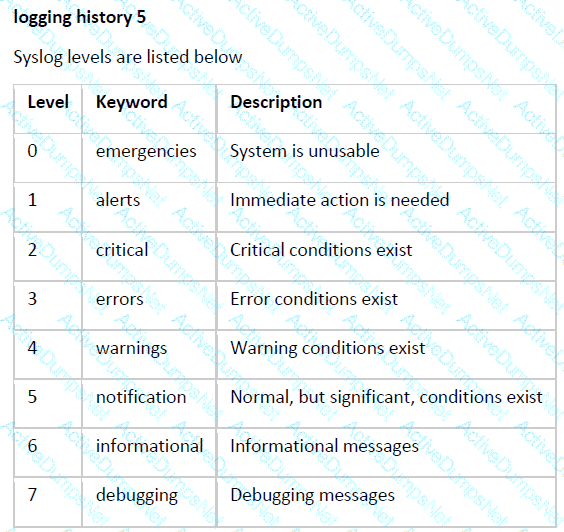

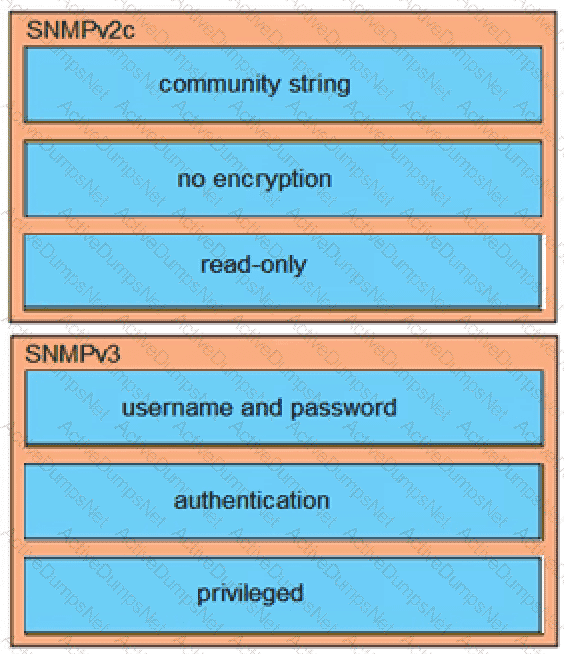 Graphical user interface, application Description automatically generated
Graphical user interface, application Description automatically generated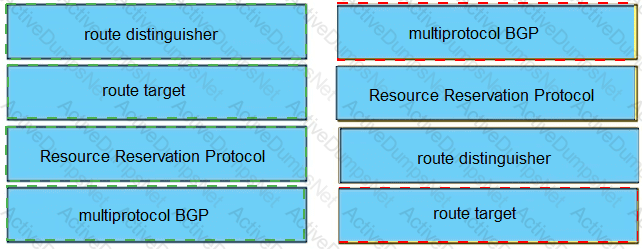
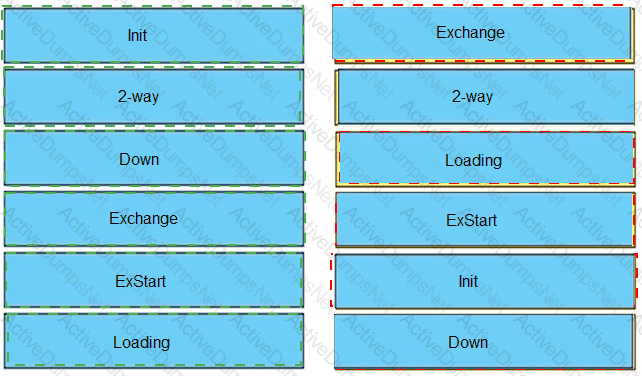
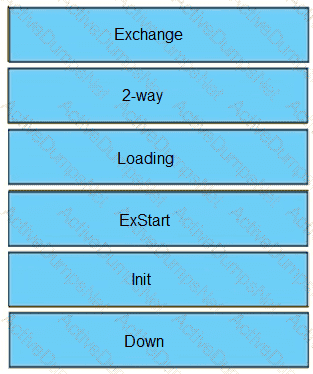 Table Description automatically generated
Table Description automatically generated
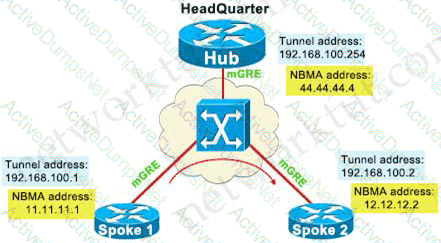

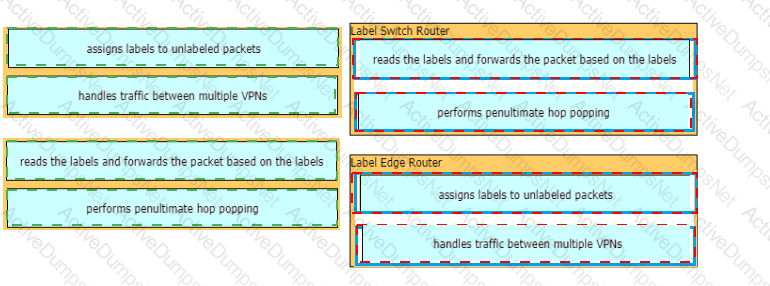
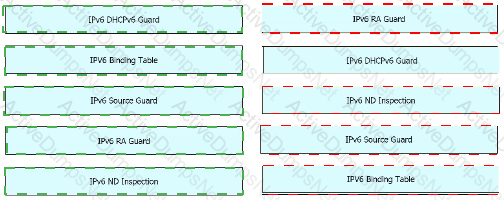
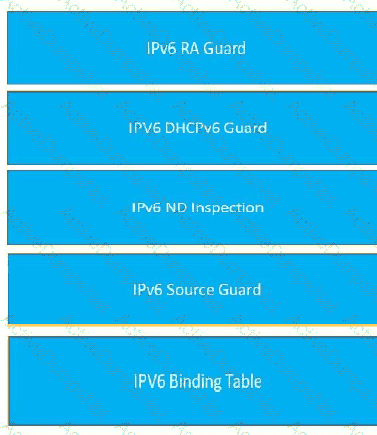 Graphical user interface, chart Description automatically generated
Graphical user interface, chart Description automatically generated